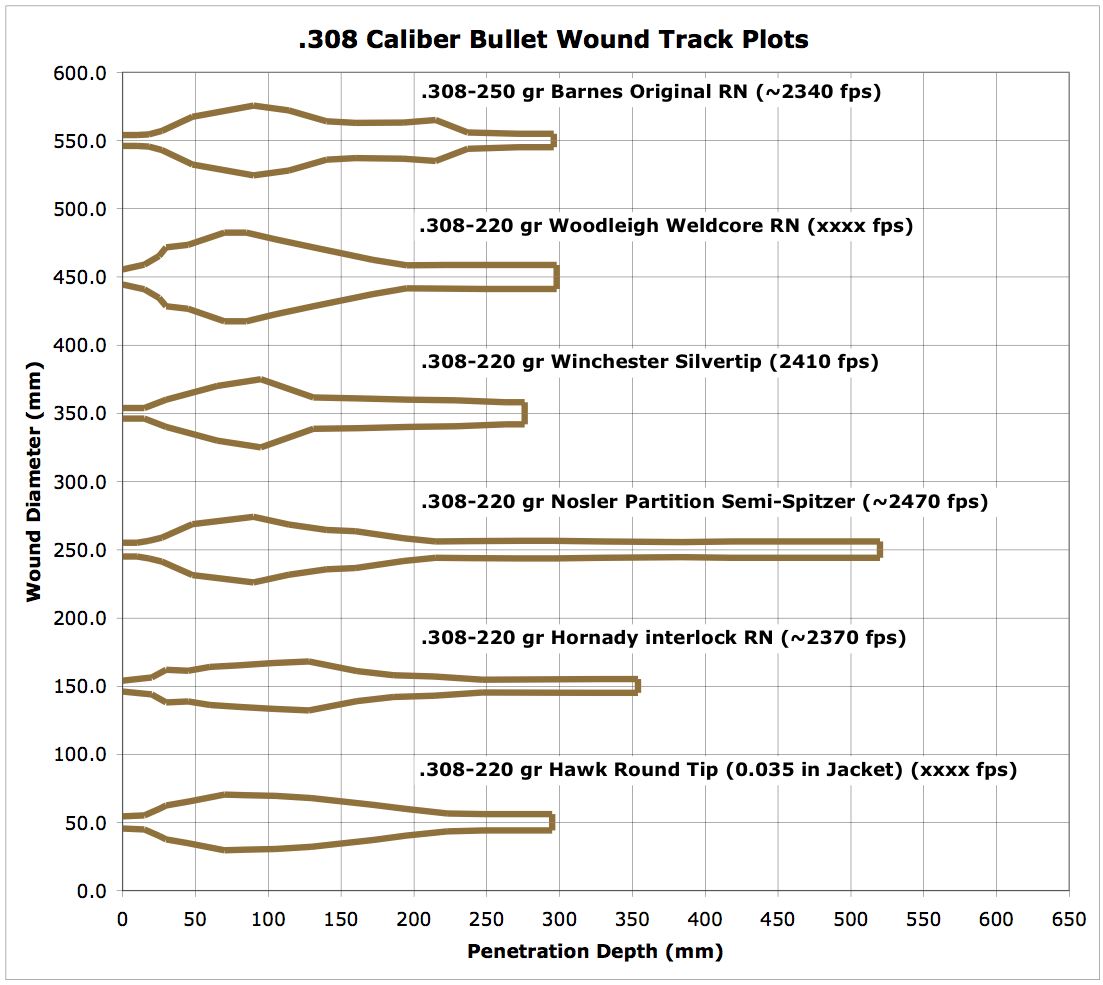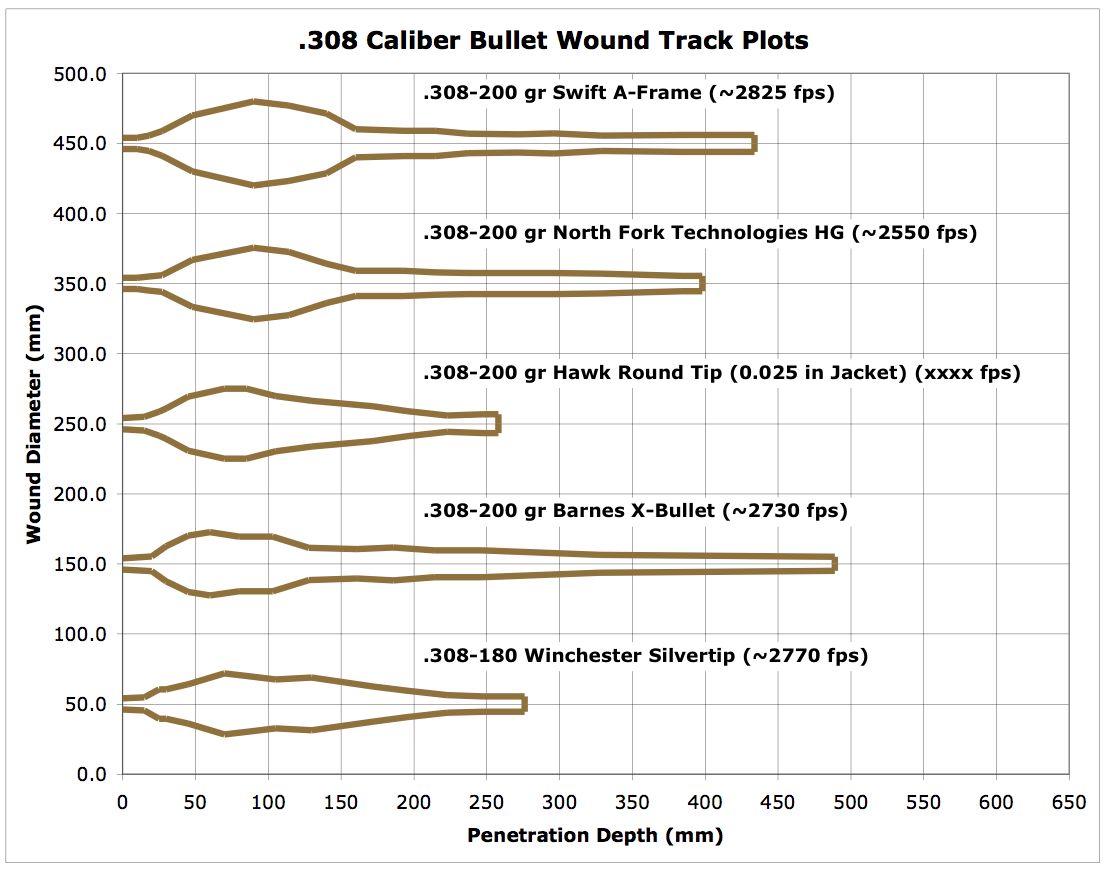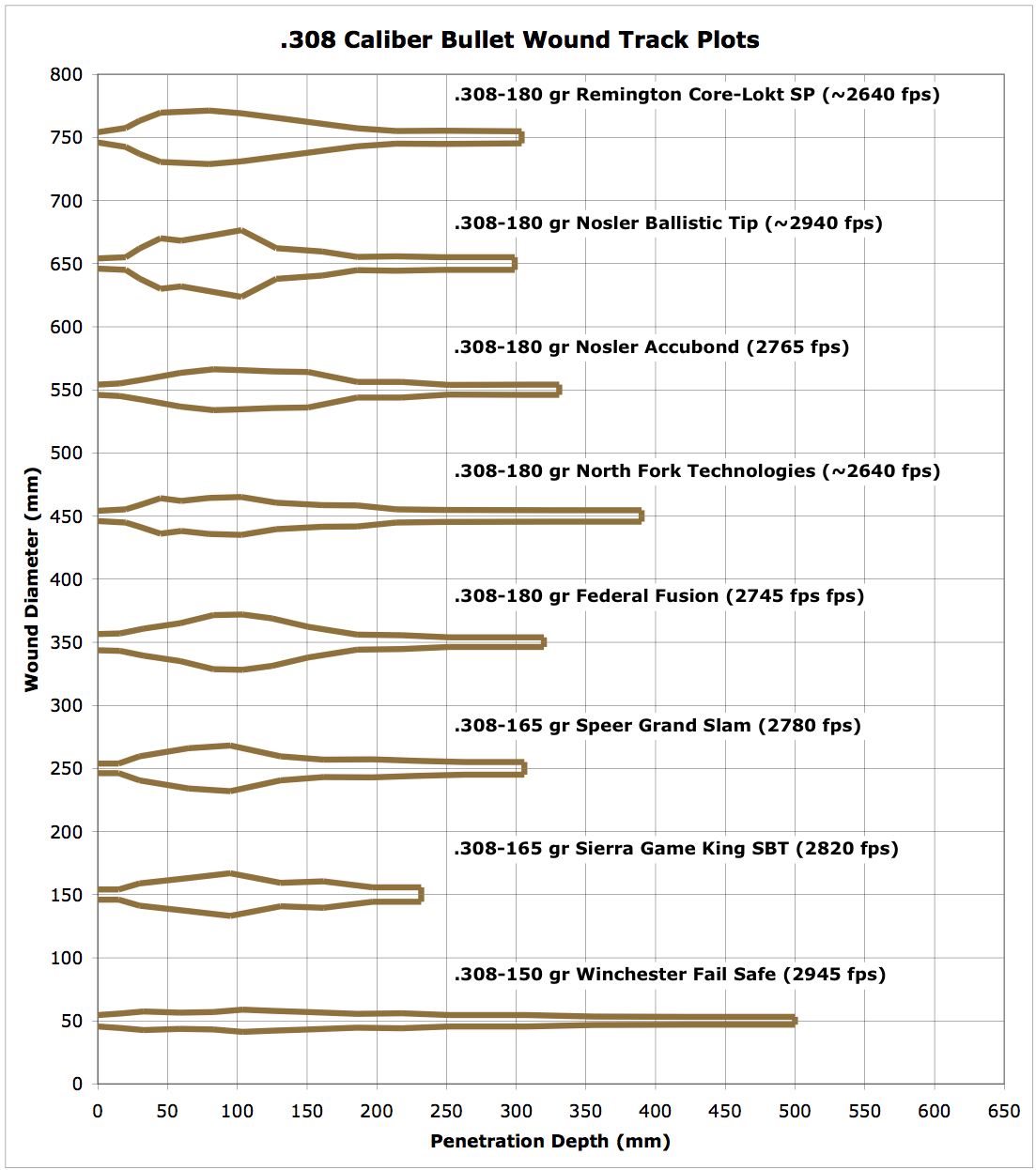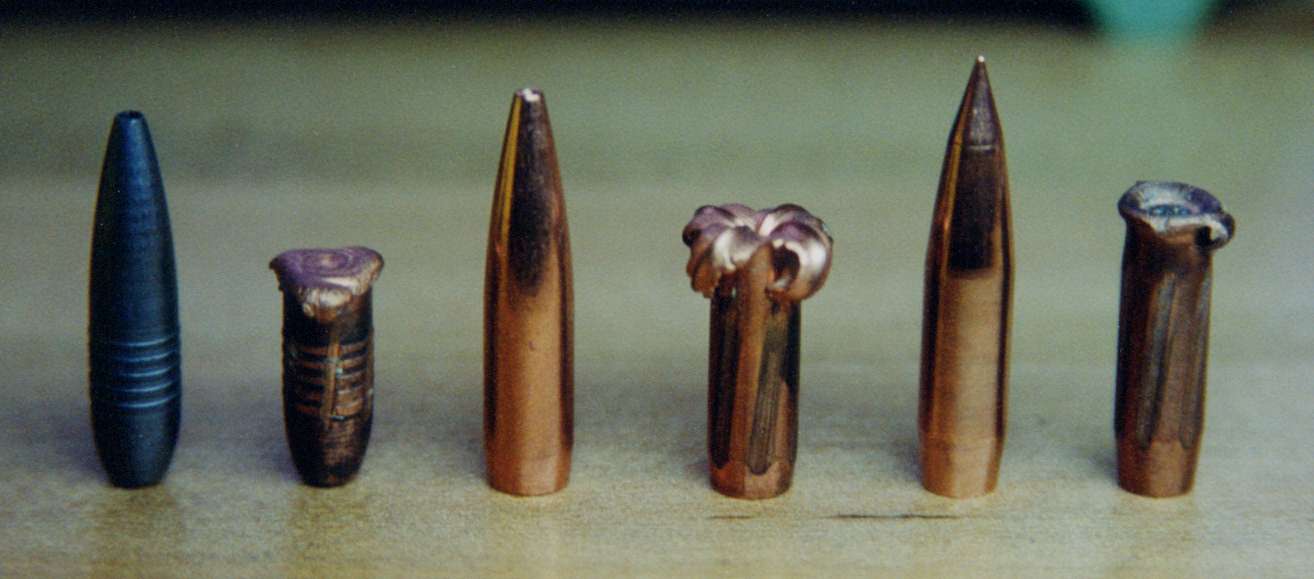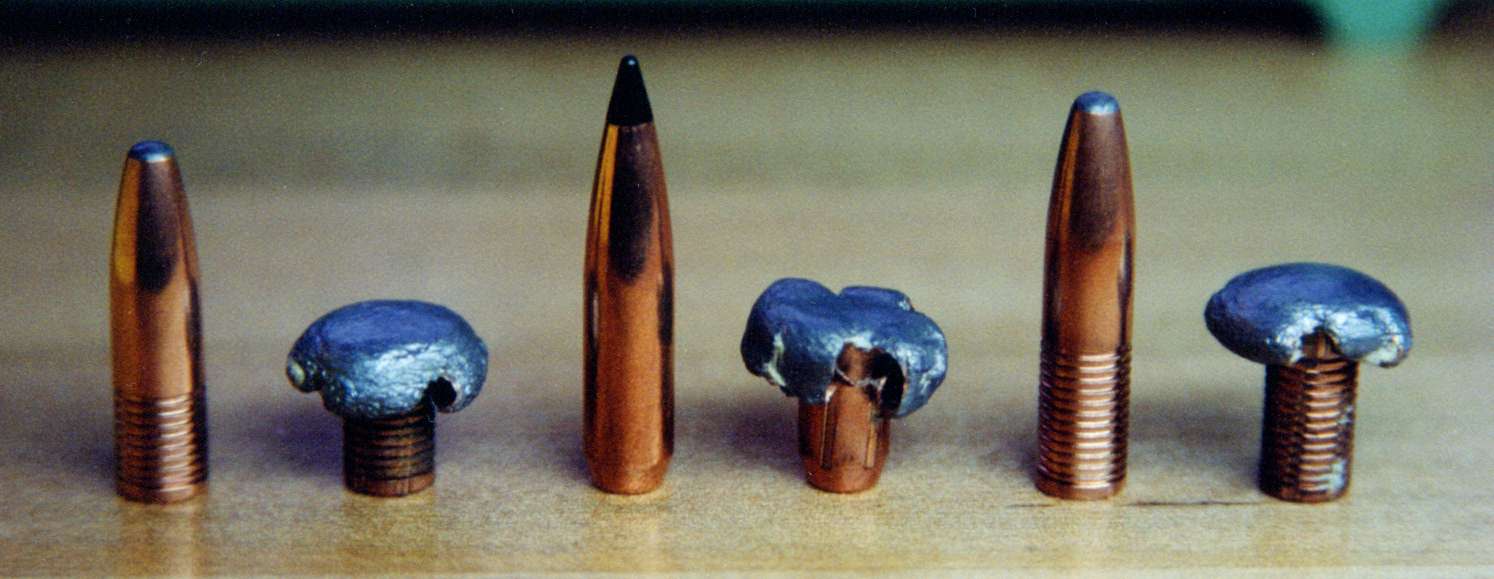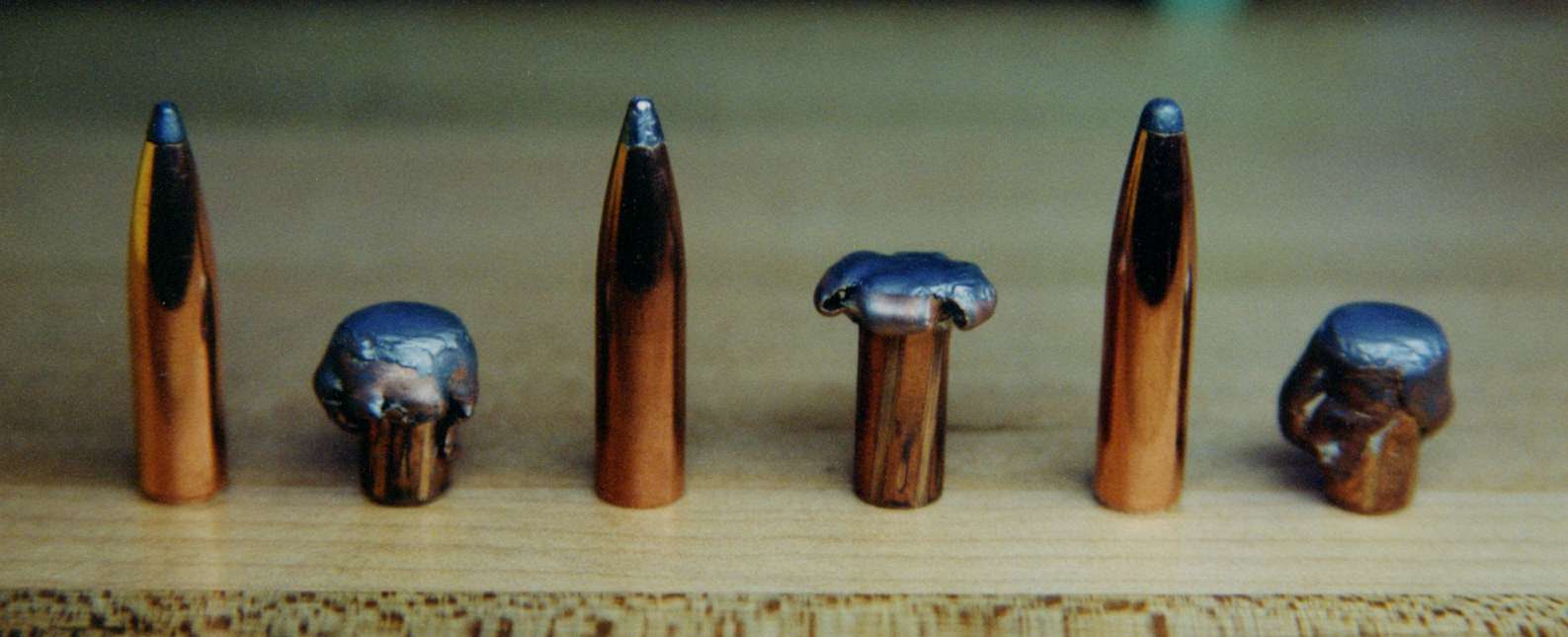IV. Empirical Methods of Estimating Actual Terminal Effect
IV. A. Performance of Non-Deforming Bullets
IV. A. i. Flat-Nosed Handgun and Rifle Bullets
There aren't many predictive methods calibrated to actual field results or to controlled tests. What there is only pertains to a particular set of circumstances, that being the use of non-deforming bullets or those which deform to an insignificant degree. Moreover, the first of these quasi-analytical models that I will describe is not reliable unless the bullet has a relatively wide flat region at its point. The following method is adapted from the work of Veral Smith of Lead Bullet Technology (LBT), as described in his book, Jacketed Performance with Cast Bullets.
He observed that the wound (or channel in test media) caused by hardcast flat-nosed lead bullets was proportional to velocity and to the diameter of the flat portion of the nose. I am impressed by the tests which he conducted, because he found by blacking the noses and shoulders of the bullet types he tested that the notion long held that a Keith-style semi-wadcutter cut a hole on the basis of its shoulder diameter (as opposed to its nose) was incorrect; the blacking on the shoulders was intact, only the nose was clean (this phenomenon may differ at much lower velocities or different nose shapes). On the basis of his testing, he developed cast bullet designs which are nearly cylindrical and feature a very wide flat point. These bullets are regarded as the ultimate in performance for handgun hunters in pursuit of heavy game and they also provide excellent performance in rifles chambered for older cartridges which accommodate the use of cast bullets. The empirical formulas which I have made on the basis of his investigations and theories are:
-
Penetration (in wetpack): PEN(FN) (inches) = Bullet Weight (lbs) x Impact Velocity (fps) / Meplat Diameter (inches) / 5 Cavitation (in soft tissue): CAV(FN) (inches) = Impact Velocity (fps) x Meplat Diameter (inches) / 225 - 0.725
These formulas give approximate values for maximum penetration and cavitation diameter in inches, again for non-deforming bullets with a relatively broad flat nose. The correlation to available data is quite good in the case of cavitation using Smith's data (see Cavitation Table and Cavitation Figure) (Note: the CAV formula has been updated, 30 Nov 2008). Whether that correlation holds for an expanded data set remains to be demonstrated by another researcher.
Reported Cavitation Data for Hard Cast Flat-Nosed Handgun Bullets
(in) |
(in) |
(fps) |
||
| .32 Magnum | 140 gr LBT FN | |
|
|
| |
||||
| .357 Magnum | 180 gr LBT FN | |
||
| |
|
|||
| .44 Magnum | 250 gr Keith SWC | |||
| 300 gr LBT LFN | ||||
| 300 gr LBT WFN | ||||
-
Reference: Veral Smith, Jacketed Performance with Cast Bullets, Lead Bullets Technology, 1984, pg. 102.
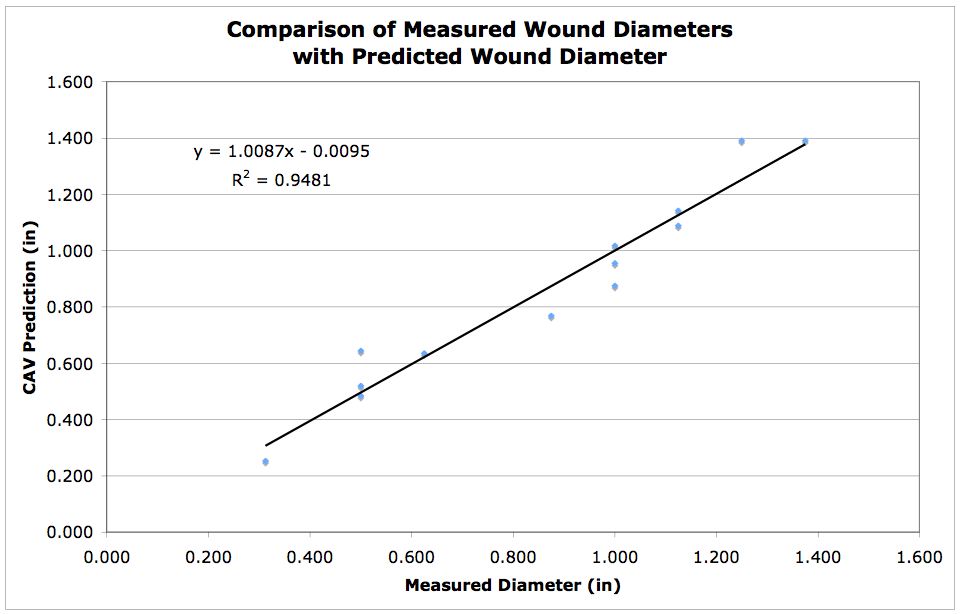
The next table (see Penetration Table) and plot figure (see Penetration Figure) describe penetration into saturated phonebooks by the heavy flat nosed handgun and rifle bullets to which I have made reference on several occasions. It is easy to see why these projectiles are favored by handgun hunters and those who hunt with large bore leverguns. The performance is even more impressive when stacked against the similar data presented in the next section devoted to deforming bullets. Bear in mind that these wound tracks (in tissue) are also of significant diameter (about 1+ inch).
Because of greater scatter in the available data (most of which is obtained from the published results of tests conducted at the Linebaugh Seminars), there is a less certain correlation for the penetration model; it may favor the meplat diameter and velocity too strongly or it may be too simplistic. I tend to think that, given the generally good fit to the data, the model is basically accurate. The variation is most probably attributable to three things: 1) inconsistency in the testing procedure, 2) bullet yaw and 3) unreported deformation. Five data points of overprediction responded well to the inclusion of a factor of 1.5 to the meplat to account for an assumed yaw; one did not. However, such overprediction occurs in only about 10% of the sample. There appears to be considerable variance between the data set presented in reference 1 and that presented by references 2 through 5. Within the reference 1 data the model appears to work with consistency if one takes into account that the semi-pointed .452-345 grain Colt Gould style bullet (particularly) and .510-460 grain NEI truncated cone bullet don't meet the criteria established for the model since they have narrow or pointed nose shapes (the Gould bullet definitely yawed while penetrating, thus had a larger presented area than its meplat and penetrated about half what it would have if it had remained stable). The yaw correction factor works well in this case. The two data points where the model grossly underpredicts the measured penetration are anomalous; I can only assume they are attributable to something in the test method. Note also, that the lowest data point is a jacketed hollow point bullet fired at an extremely low velocity from a .38 Special that does not deform and (predictably) behaves like a hard cast flat-nose bullet.
Field results corroborate the ballistic testing. Ross Seyfried has gotten almost five feet of penetration with the .475 Linebaugh using a modified Trophy Bonded Sledgehammer solid weighing 385 grs at 1500 fps muzzle velocity on an Asian buffalo in Australia, in spite of breaking both the hip and a shoulder! (Ross Seyfried, ".475 Revolver Down Under", Guns & Ammo, Petersen Publishing, Inc., December, 1989, pp. 48 - 53, 96) In testing this bullet outpenetrated the lead alloy LBT bullets by 20 %. Using a similar modified solid weighing 400 grs, Otto Candies, Jr. completely penetrated the skull of an elephant on a frontal brain shot, the bullet coming to rest at a depth of 40 inches in the neck. (Jim Gosnell, "Legendary Linebaugh Big-Bores", High-Power Handguns, Petersen Publishing, Inc., 1995, pp. 34 - 39) J. D. Jones, noted handgun hunter and entrepreneur (S.S.K. Industries), reports getting "over seven feet" of penetration with 500 gr. solids from a 45-70 handcannon (SSK product literature).
Reported Penetration Data for Hard Cast Flat-Nosed Handgun and Rifle Bullets
| Caliber / Cartridge | Bullet Type / Mass | Velocity |
Diameter |
Penetration |
Depth |
Note |
| .38 Smith & Wesson Special | 125 gr JHP | |||||
| .375 Huff Short Super Magnum | 230 gr LBT LFN | |||||
| .41 Special | 230 gr SWC | |||||
| .41 Remington Magnum | 210 gr Unspecified | |||||
| 220 gr Mt Baldy Keith | ||||||
| 260 gr LBT LFN | ||||||
| .410 GNR | 250 gr Cast Performance WFN | |||||
| .44 Smith & Wesson Special | 255 gr Cast Performance WFN | |||||
| .44 Remington Magnum | 250 gr Keith | |||||
| 300 gr LBT (WFN?) | ||||||
| 300 gr LBT (WFN?) | ||||||
| 340 gr LBT LFN | ||||||
| .45 Auto (Rimmed) | 240 gr Keith | |||||
| .45 Colt | 250 gr Factory Lead RN | |||||
| 265 gr Mt Baldy Keith | ||||||
| 265 gr Keith | ||||||
| 300 gr Unknown | ||||||
| 300 gr LBT LFN | ||||||
| 310 gr Keith | ||||||
| 330 gr LBT LFN | ||||||
| 335 gr Cast Performance LFN | ||||||
| 345 gr NEI Gould | ||||||
| 350 gr LBT LFN | ||||||
| 350 gr LBT LFN | ||||||
| 350 gr LBT LFN | ||||||
| .454 Casull | 300 gr LBT LFN | |||||
| 315 gr Belt Mountain Punch Bullet | ||||||
| 360 gr Cor-Bon FN Penetrator | ||||||
| .45-70 Springfield | 530 gr Garrett Hammerhead | |||||
| .45-75 Winchester | 350 gr LBT (LFN?) | |||||
| .480 Ruger | 306 gr LBT LFN | |||||
| 390 gr Cast Performance LFN | ||||||
| .475 Linebaugh | 405 gr LBT (WFN?) | |||||
| 420 gr LBT LFN | ||||||
| 420 gr LBT LFN | ||||||
| 420 gr LBT LFN | ||||||
| 430 gr LBT (LFN?) | ||||||
| 440 gr LBT LFN | ||||||
| .475 Maximum | 430 gr LBT LFN | |||||
| .470 Nitro Express | 458 gr Belt Mountain Punch Bullet | |||||
| .500 Linebaugh | 420 gr LBT LFN | |||||
| 435 gr LBT LFN | ||||||
| 435 gr LBT WFN | ||||||
| 435 gr LBT WFN | ||||||
| 440 gr NEI Keith | ||||||
| 450 gr Belt Mountain Punch Bullet | ||||||
| 460 gr NEI TC | ||||||
| 480 gr Keith | ||||||
| 485 gr LBT LFN | ||||||
| 495 gr LBT LFN | ||||||
| 500 gr LBT LFN | ||||||
| .500 Maximum | 450 gr LBT (LFN?) | |||||
| 590 gr LBT (LFN?) | ||||||
| .500 Smith & Wesson | 440 gr LBT WFN | |||||
| 440 gr LBT WFN | ||||||
| 440 gr LBT WFN | ||||||
| .50 Alaskan | 458 gr Belt Mountain Punch Bullet | |||||
| 505 gr LBT (WFN?) | ||||||
| 540 gr LBT LFN |
-
1 -- Ross Seyfried, "The .500 Magnum", Guns & Ammo, Petersen Publishing, Inc., August, 1986, pp. 36 - 41, 78.
2 -- Ross Seyfried, ".475 Monster Magnum", Guns & Ammo, Petersen Publishing, Inc., May, 1988, pp. 36 - 39, 86 - 87.
3 -- Jim Gosnell, "Legendary Linebaugh Big-Bores", High-Power Handguns, Petersen Publishing, Inc., 1995, pp. 34 - 39.
4 -- Kent M. Batchelor, "Penetration Test at the Linebaugh Seminar", http://www.sixgunner.com/linebaugh/penetration_test.htm.
5 -- 2002 - 2004 Linebaugh Seminar penetration test data reported at: http://www.handloads.com/misc/linebaugh.penetration.tests.asp
(References: http://www.sixgunner.com/linebaugh/penetration_test.htm, http://forums.sixgunner.com/topic.asp?TOPIC_ID=5110, http://forums.sixgunner.com/topic.asp?TOPIC_ID=10571)6 -- Unspecified, assumed value
7 -- Includes bone; paper only test exhibited excessive yaw or data not available (in parentheses)
8 -- Effective meplat assumes yaw
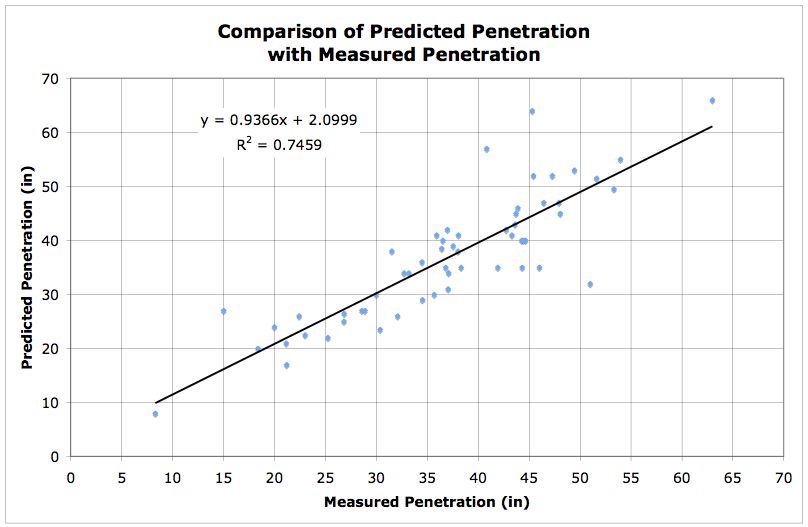
In these empirically-based expressions for flat-nosed bullets, penetration is seen to be a function of momentum and represented diameter, while cavitation is a function of velocity and represented diameter; these tend to agree with common sense as well. If you multiply these two formulas together you obtain a relationship (discounting the constants) with the units of energy, which agrees with terminal ballistic theory in that wound volume should be proportional to kinetic energy (observe that cavitation may be equivalently expressed as specific energy times unit area).
In principle, these are the ideal cases and the theory could be extended to describe the behavior of deforming bullets. Unfortunately, at this point many additional variables suddenly enter into the calculation which are extremely difficult to evaluate, including jacket hardness, thickness and ductility, lead core hardness and malleability, and variations in these quantities from the nose to the base of the bullet. In the case of a non-deforming bullet the event can be crudely linearized without doing serious mischief to the analysis. But in the case of an expanding bullet, the rate of deformation is central to the accurate description of its performance and there is no direct method of determining this function from simple physical relationships of mass, velocity and material strength (assuming you knew it) without resorting to the kind of computation intensive finite element and finite difference hydrocodes referred to earlier. In the next segment, The Modeling of Terminal Ballistics, we will address an alternative approach to solving this problem.
IV. A. ii. Round-Nosed Solid Rifle Bullets
Round-nosed bullets vary considerably in performance. I have struggled to correlate this performance to any consistent feature of geometry (e.g., ogival radius of curvature) to my satisfaction. However, lately (April 2009) I have renewed the quest and obtained some encouraging results. While this type of bullet is not particularly well suited to most hunting and defense applications, it remains the standby for dangerous game and for reliability in many types of automatic pistols.
The following data (see Solid Penetration Table) is for solids fired into spaced 3/4 inch plywood (in the case of the data from references 1, 5 and 6) and into wet newsprint (in the case of the data from references 2, 3, 4 and 7). These results illustrate two things. Firstly, the aforementioned variation in performance for round nose bullets is clearly evident (note that there are some flat nosed bullet data in this set as well). Theoretically, in a crude analysis, the various .416 loads have the same performance, when in actuality the Barnes Super Solid penetrates only two-thirds as far as the traditional Kynoch solid (not necessarily to its discredit). The influence of the shape of the nose accounts for this difference entirely. Against dangerous game the more blunt-nosed Barnes bullet would produce a larger diameter wound. Its a question of what one requires. Secondly, the data demonstrates what many seasoned hunters have observed: that the .400s, .416s and .425s penetrate about as well as their larger caliber cousins launching heavier bullets with more recoil. (This is one of the difficulties in developing an analytical model of the penetration performance, because there is hardly enough spread in the data to get a good linear fit.) I hope to show in the near future how medium-bore and small-bore solids stack up against the big bores.
Applying the Veral Smith derived flat-nosed PEN calculation to these data does not correlate at all (R2 ~0.0001) unless you apply a shape factor to account for nose differences. Surprisingly, even a crude pass at this shape factor immediately yields promising results (R2 ~0.60). However, an expression yielding a much closer fit to the data (R2 ~0.92) is found by applying a simple shape factor the following:
-
Penetration in Spaced Plywood: PEN(RN) (inches) = Impact Velocity (fps) x Sectional Density x Shape Factor / 10
Where the shape factor is an arbitrary unitless parameter. I have used a value of either 0.60 or 0.44 in the following plot (see Solid Penetration Figure), the former for very blunt, hemispherical round noses (e.g., Barnes and A-Square monolithic designs) and the latter for more traditional, somewhat tapered round noses (Kynoch, Woodleigh and Hornady designs). For the sake of consistency, the same rule has been applied for broad flat-noses (e.g., GS Custom) and for flat-noses with small meplats (e.g., Speer AGS).
Reported Data for Penetration of Solid Rifle Bullets
| Caliber / Cartridge | Bullet Type / Mass | Velocity |
(Plywood) |
(Wet Newsprint) |
|
| .375 Holland & Holland Magnum | 300 gr Hornady FMJ RN | ||||
| .375 H&H Magnum Improved | 300 gr Hornady FMJ RN | ||||
| .416 Remington Magnum | 400 gr Hornady FMJ RN | ||||
| 400 gr Barnes Super Solid RN | |||||
| .416 x .375 H&H Improved | 410 gr Kynoch FMJ RN | ||||
| .416 Rigby | 400 gr Barnes Super Solid RN | ||||
| .45-70 Springfield | 450 gr Barnes Super Solid RN | ||||
| .458 Winchester Magnum | 450 gr GS Custom FN | ||||
| 500 gr Hornady FMJ RN | |||||
| .450 Ackley | 400 gr Barnes Super Solid RN | ||||
| 500 gr Trophy-Bonded Sledgehammer FN | |||||
| 500 gr Speer African Grand Slam FN | |||||
| 500 gr Hornady FMJ RN | |||||
| .460 Guns `n Ammo | 450 gr GS Custom FN | ||||
| .458 x .404 Jeffery Improved | 500 gr Hornady FMJ RN | ||||
| .470 Nitro Express | 458 gr Grizzly Belt Mountain Punch FN | ||||
| 500 gr Barnes Super Solid RN | |||||
| 500 gr Trophy Bonded Sledgehammer FN | |||||
| 500 gr Woodleigh FMJ RN | |||||
| .470 Mbogo | 500 gr Barnes Super Solid RN | ||||
| 500 gr Woodleigh FMJ RN | |||||
| 500 gr Trophy Bonded Sledgehammer FN | |||||
| .505 Barnes Supreme | 700 gr Barnes Original FMJ RN | ||||
| .500 Nitro Express | 570 gr Woodleigh FMJ RN | ||||
| 600 gr A-Square Monolithic Solid RN | |||||
| .500 Jeffery | 525 gr Barnes Super Solid RN | ||||
| .500 A-Square | 570 gr Woodleigh Solid RN | ||||
| 600 gr A-Square Monolithic Solid RN | |||||
| .600 Jeffery Nitro Express | 900 gr Barnes Original FMJ RN |
-
1 -- George L. Hoffman, "The .416 Lives Again!", Big Bore Rifles and Cartridges, Wolfe Publishing, Inc., 1991, pp. 262 - 265.
2 -- Terry Wieland, "The Big .450s" [publication unknown].
3 -- Jim Gosnell, "Legendary Linebaugh Big-Bores", High-Power Handguns, Petersen Publishing, Inc., 1995, pg. 37.
4 -- Kent M. Batchelor, "Penetration Test at the Linebaugh Seminar", http://www.sixgunner.com/linebaugh/penetration_test.htm.
5 -- Andrew C. Tillman, correspondance with the author and George Hoffman.
6 -- Dave Estergaard, "Comparing the Big Bores", http://www.470mbogo.com/BigBores/BigBores.html. Note: data adjusted to remove gaps between boards.
7 -- 2002 - 2004 Linebaugh Seminar penetration test data reported at: http://www.handloads.com/misc/linebaugh.penetration.tests.asp
(References: http://www.sixgunner.com/linebaugh/penetration_test.htm, http://forums.sixgunner.com/topic.asp?TOPIC_ID=5110, http://forums.sixgunner.com/topic.asp?TOPIC_ID=10571)8 -- Exited the back of the test enclosure; total penetration unknown.
9 -- Bullet tumbled and/or interacted with enclosure
10 -- Includes bone; paper only test data not available
11 -- Velocity not reported, value shown is estimated
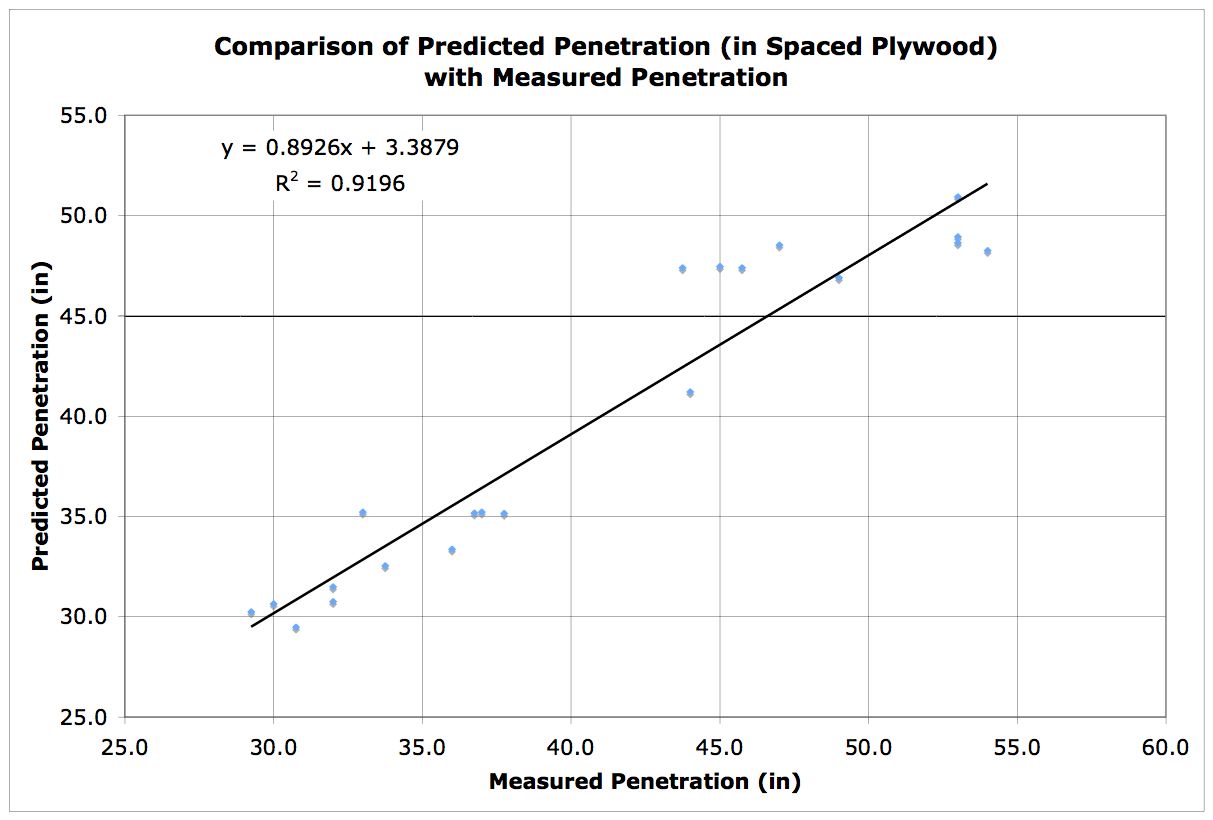
It seems that a generalized expression for estimating the penetration both flat-nosed and round-nosed bullets should be obtainable, wherein the shape factor is expressed as a ratio of the effective nose diameter (or meplat diameter) to the bullet diameter. The only common data set for both flat-nosed and round-nosed bullets that I have is taken from tests with wetpacks, so its slightly different. Adapting the preceding expression, the following is obtained:
-
Penetration in Wetpack: PEN(Solid) (inches) = Impact Velocity (fps) x Sectional Density x Shape Factor / 10 Where, Shape Factor = Bullet Diameter (in) / Effective Nose Diameter (or Meplat Diameter) (in)
Considering the problems with the wetpack data set (imprecise methods, numerous instances of yaw and exits, inconsistency in the media, etc.), the correlation is better than it ought to be (R2 ~0.65). The generalized penetration formula, while it works, is not as good at predicting the performance of flat-nosed bullets as the specialized PEN(FN) formula, notably on the low end of the scale. Its hardly worth showing the plot (see Generalized Penetration Figure) because of the scatter in the data, but something remarkable emerged from this exercise.
If you look at the terms in this expression, recalling that sectional density is bullet weight (in pounds) divided by the square of the nominal bullet caliber (in inches), observe that the bullet diameter term in the numerator of the shape factor cancels one of the bullet diameter terms in the sectional density, leaving a kind of modified sectional density expression in which the bullet diameter is multiplied by either the meplat (for a flat-nose) or an effective nose diameter (for a round-nose). What I found was that while I simply used the actual meplat diameter, it was necessary to use a factor in the case of round noses that resulted in an effective diameter larger than the bullet diameter. Here also I have found that two values suffice for a fairly broad set of data, taking 1.5 times the nominal caliber for very blunt noses and 1.2 times the nominal caliber for more traditional noses.
Understand the implications of this. It means that there is evidently something inherently efficient about the penetration of very broad flat-nosed solids (small meplats behave like conventional round noses). If you examine the bullets for which this behavior holds, the ratio of the meplat to the bullet caliber is typically 0.7 or larger. I suspect that the effect is a minimization or even a damping of bullet yaw and that there is a point between a meplat ratio of 0.7 and 0.5 where an abrupt transition occurs. Now, I understand that very broad noses like this are unpopular with users of repeating rifles because they have a nasty habit of snagging on the magazine rim or feed ramp, but for single shots and double rifles they really ought to be considered.
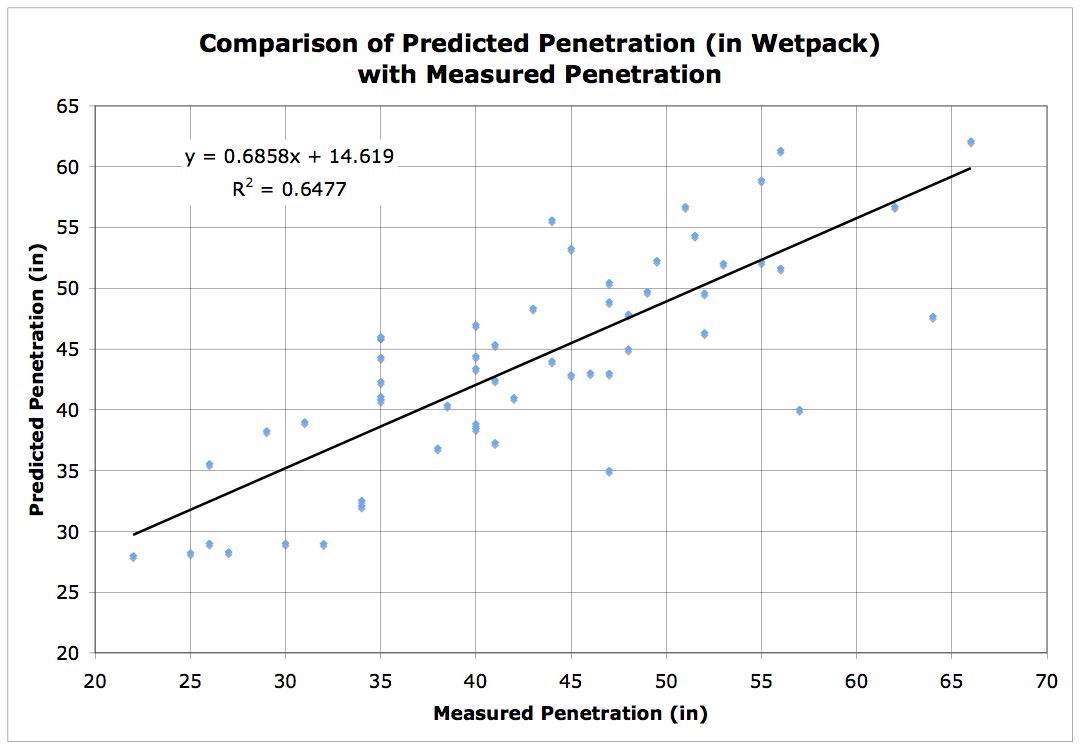
Obviously, the larger diameter solids produce more damage, though solids tend not to create large wounds. Their primary advantage is reliable and deep penetration and they are best employed in situations in which the bullet must penetrate heavy bone structures or through great depth of hard muscle and non-vital organs in order to reach the vitals. For instance, a follow-up shot at a retreating Cape buffalo that has to travel from the hindquarters across the paunch guts to the heart or lungs. No softpoint will reliably do that. Hunters, and particularly hunters of dangerous game, tend to think in terms of heavy hitters for knockdown effect - but its not the force of the delivered blow that produces lethality and sometimes that can be a misleading indicator of effectiveness.
The difference in the impact delivered to the target between solids and softpoints is illustrated by a case from my own experience. I shot a stout and somewhat rotten hardwood stump with my 45-70 Contender using 400 gr Speer soft points (1600 fps) and some 500 gr Lee FN hardcast "solids" (1350 fps) with a rather small meplat. The soft points did not exit and bowled the heavy stump over, whereas the solids zipped right through without causing it to quiver. Both the power delivered (energy per unit time) and the impact force were tremendous. However those soft points would be inappropriate for use against dangerous thick-skinned game for anything but clean broadside shots (if then). Against a Cape buffalo, the mere impact alone would be trifling, but a solid that broke both shoulders, ruptured both lungs and shattered the spine would not be something it could shrug off. It would also be very dodgy to have to take a brain shot head-on against any buffalo, hippo, rhino or elephant with most softpoints - especially if pushed to high velocity.
Lastly, even stoutly constructed bullets can go to pieces on impact with very hard surfaces, especially at high velocity. Despite the glowing praise of the following test depiction, one wonders what the bullet's performance would have been if it had hit a brick (or the shoulder bones of an elephant) on entrance rather than exit. Shattering, no doubt, but perhaps also a bit short.
...[The] 500-grain Trophy Bonded Sledgehammer Solid left the muzzle at a surprising 2,450 [fps], blasted a tunnel straight as a die through 44 inches of newsprint, bored right through the three-quarter-inch plywood backstop, utterly destroyed the first brick that was bracing it and smashed the second, destroying itself in the process. What's left of that bullet should be buried with full military honors. If the bricks hadn't been there, it might still be going. (Terry Wieland, "The Big .450s")
Understand that I am not criticizing the bullet design. The original Trophy-Bonded Sledgehammer Solid had a flat point very similar to the hard cast handgun bullets of SSK and LBT (current production bullets have a much smaller meplat), but its lead core is armored in a massive naval bronze jacket. These are excellent solids, but even the best lead cored bullet can be destroyed. I have never seen a monolithic brass (as opposed to copper) solid bullet appreciably damaged by impact with bones or any test media.
IV. B. Performance of Deforming Bullets
Possibly the most significant study on terminal performance of the last many years, from the perspective of the sportsman (if not that of the defense analyst), was documented in the June 1998 issue of Handloader magazine (Gary Sciuchetti, "The Best Hunting Bullet", No. 193, pp. 40 - 44). The author conducted an exhaustive and apparently well considered analysis of .308 caliber 180 grain bullets. His results are a little startling.
Although some scientifically minded individuals may object to the test media used (saturated phonebooks), the author prudently tested a variety of media under different conditions and correlated these to shots made into deer cadavers along several shotlines of interest to the hunter. The author's choice of saturated phonebooks was largely driven by practical considerations, but his calibration tests into deer cadavers distinguish his experiments from those of a great many investigators who have not taken the time to examine this aspect. The average shooter has recourse to this medium and there is a large body of test data using it. It is difficult to oversaturate a phonebook such that the results will be skewed, however undersaturation is a possibility to be guarded against. Wet phonebooks work, are not temperature sensitive and remain stable for at least 48 hours after removal from water.
It is worth noting that serious objections may be raised against any test medium, including properly prepared ballistic gelatin. Gelatin is fully elastic up to the point of rupture; thus, it does not preserve a permanent crush cavity as is seen in tissue, only very small cavities along the projectile or particle paths and a field of radiating cracks resulting from the temporary cavity expansion and ultimate tensile failure. A certain amount of judgment is required to separate a realistic permanent crush cavity from this result. This may be shocking news to some, but it is true. Gelatin also replicates muscle far better than soft, gas-filled organs (lungs) or weak, blood-filled vital organs (liver). The mechanical properties of gelatin (and the cavities produced in it) vary strongly with mix formulation and especially with temperature. The considerable difficulties in preparing, storing, transporting and calibrating ballistic gelatin argue strongly against its use by anyone other than a knowledgeable professional equipped with an indoor range and an industrial walk-in refrigerator. Ballistic gelatin will be ruined if improperly (e.g., with hot water) or inconsistently prepared, if it is not aged and tested at a precise temperature, etc. Those interested in seeing a wide variety of ballistic gelatin test results should look at the Brass Fetcher Ballistic Testing sites (including the Original Older Data).
In the first place what Sciuchetti's results indicate (which I ought to have made clear earlier) is that a bullet of any given construction and impact velocity may have significantly varying performance depending upon the part of the game struck and the shotline through the target. This is not merely a question of the depth of target, but more importantly of the muscle and bone structures encountered. I hold homogeneity and consistency to be supreme attributes for a test medium, but homogeneity is a valid complaint from one perspective: game animals aren't homogeneous. It is one reason why experienced hunters so often emphasize the importance of proper shot placement and shotline selection. The variations in penetration shown by different media in this context can be seen to give a similar spectrum of results (not necessarily correlating to the same degrees of deformation). The data the author used for ordnance gelatin tests correlated well with lengthwise shots encountering some ribs and portions of the spine, a good example of typical shot conditions. If major bones are struck (shoulder) the penetration is right at half the depth observed in gelatin tests or two-thirds of the depth in saturated phonebooks; if no bones are hit the actual penetration may be almost 50 % greater than the gelatin depth and nearly 75 % more than in the phonebooks. In general terms, the depth in ordnance gelatin was approximately 30 % deeper than in wet phonebooks. Although saturated phonebooks are a somewhat tougher target than ordnance gelatin, they can be treated to behave as a relatively consistent homogeneous media (which is what is desired).
The author's results indicate large scatter in the data, yet as much as 20 % variation (from the mean) in the depth of maximum cavitation is observed in properly prepared ordnance gelatin according to Dr. Martin L. Fackler. (In the case of improperly prepared ordnance gelatin the variation can be far more, especially in the extent of cavitation.) Assuming the test method is consistent (i.e., not a source of scatter in its own right), this phenomenon is attributable to what is called a "normal distribution" and demonstrates the importance of conducting multiple shots for each test condition in order to make meaningful measurements, and also of calibration shots.
In order to examine trends in the Sciuchetti data, I have plotted the penetration test results for most common bullet brands and designs. These are arranged in four classes:
The green curve is a high order polynomial fit to all of the data points just to show the prevailing trend. Each of the four plots is followed by a detail plot on a smaller scale which better represents the region of practical interest.
IV. B. i. The Handloader-Sciuchetti Study

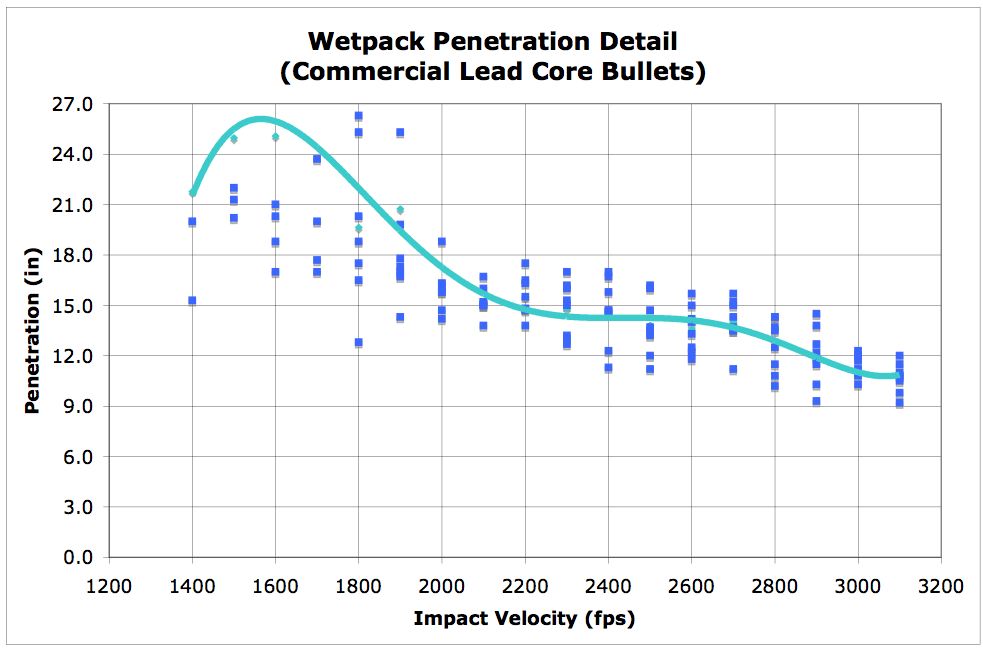
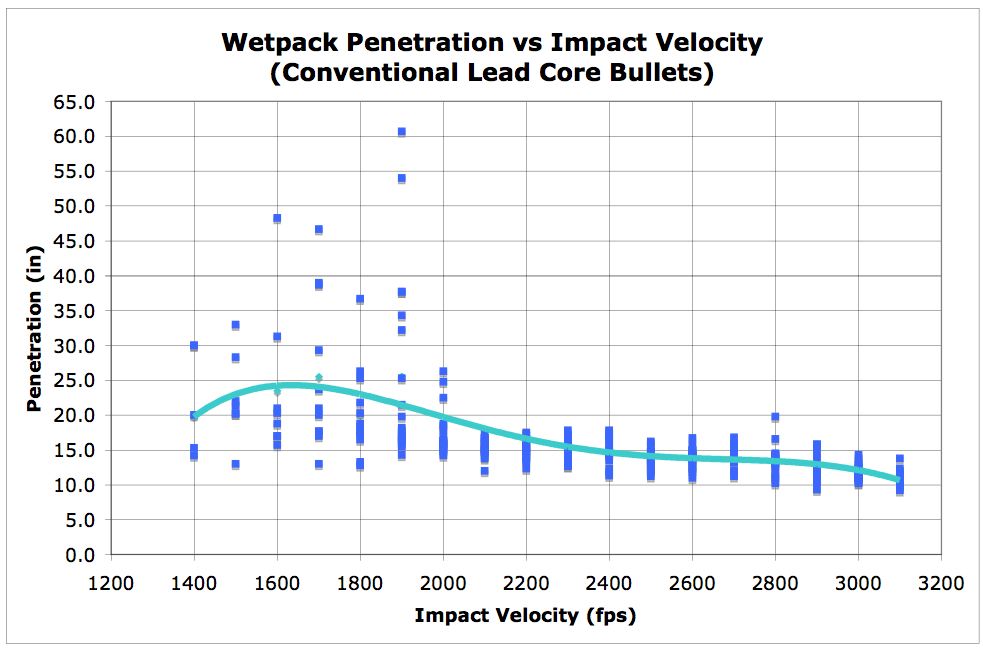
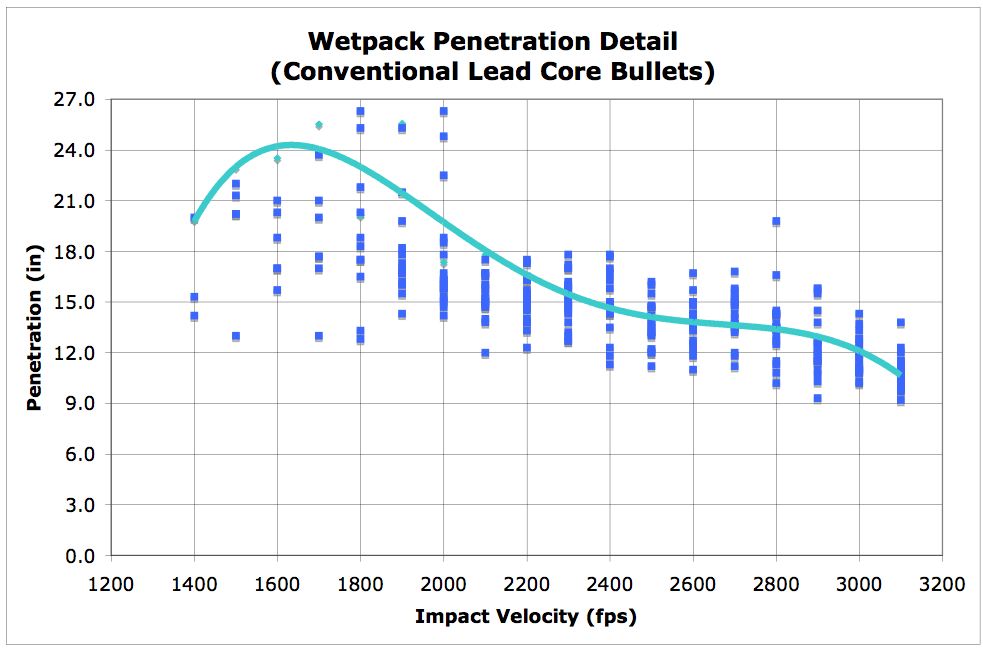

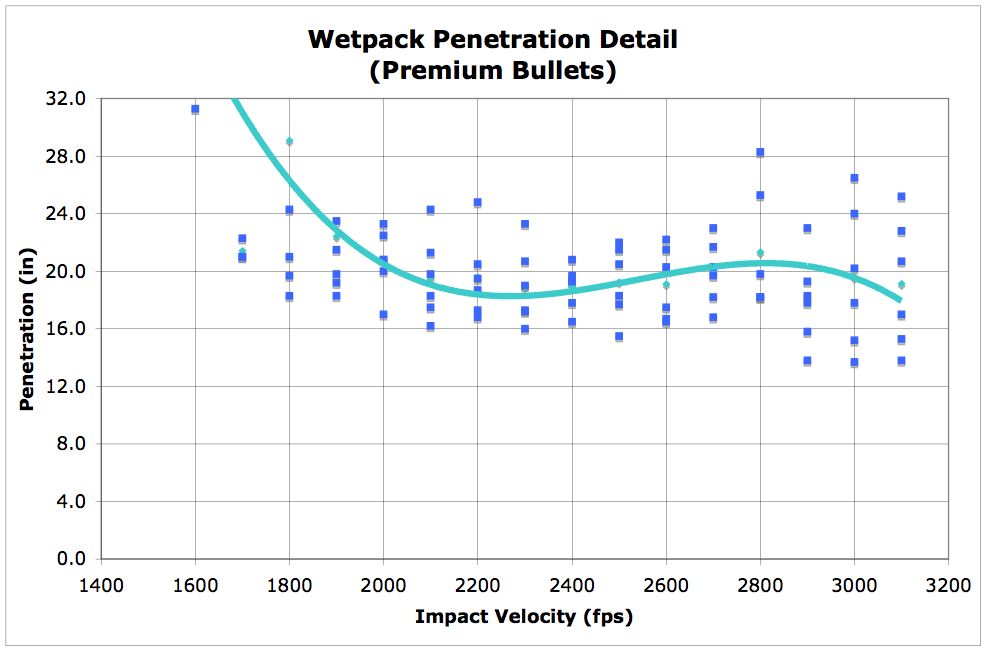
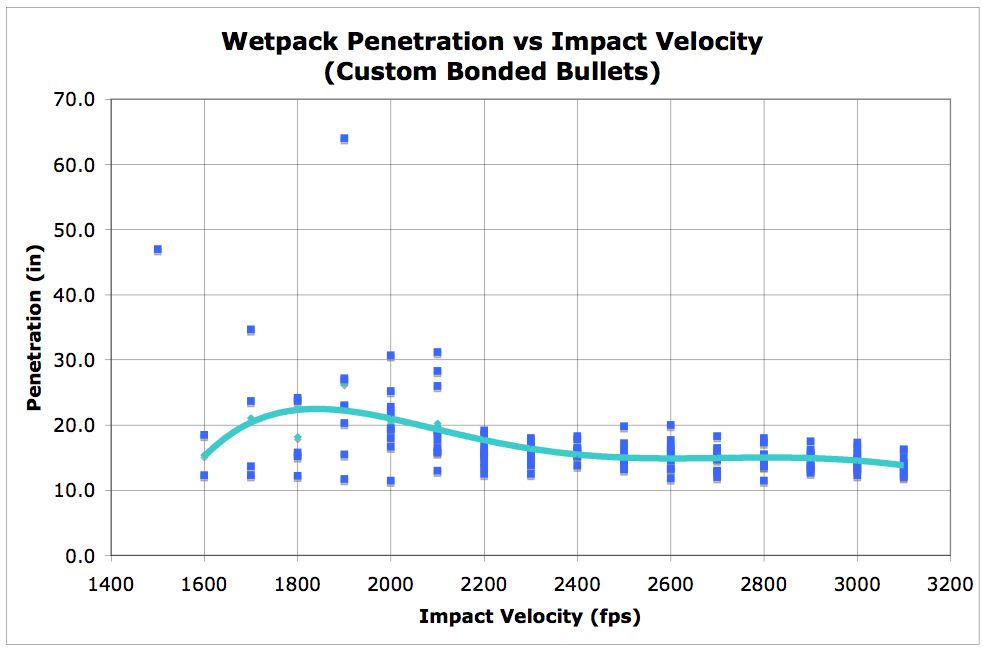
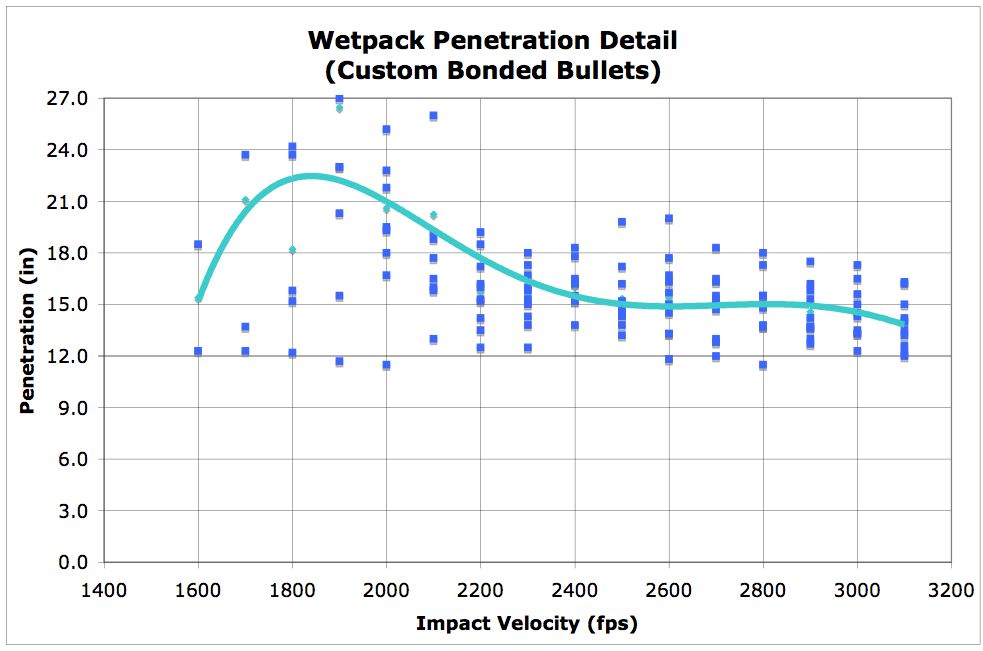
Perhaps the most striking observation from this penetration data is that increasing velocity has a detrimental effect on penetration for nearly all bullets over the entire velocity range of interest. This result surprised me because, while I knew from anecdotal evidence that very high velocities caused even heavy jacketed bullets to fragment or overexpand, I expected that this fall off in penetration performance would only occur at velocities above 2800 fps or so and, that for any given design, there would be a peak in the penetration performance curve, with diminishing penetration following diminishing velocity. In fact, what is observed is that penetration reaches a limiting upper value rather quickly at the lowest velocity the bullet will deform (the hydrodynamic penetration velocity or the plastic velocity) and that penetration tends to deteriorate steadily at all higher velocities. Hard bullet designs exhibit an abrupt step function behavior at this velocity.
The very best performers, in terms of penetration, are those non-bonded premium bullets (e.g., the Barnes X-Bullet and Nosler Partition) which exhibit (on average) essentially constant penetration (~19 inches) over the entire velocity range of interest. The bonded bullets, again on average, are somewhat better (~10%) at penetration than conventional bullets; managing 15+ inches in depth up to an impact velocity of ~2900 fps, against only 2100 to 2300 fps for the conventional and commercial classes of bullet. Yet the non-bonded premium bullets penetrate significantly deeper than the bonded bullets - about 25% more.
The difference is the degree of expansion, which is a consequence of design. Specifically jacket to core bonding controls the retained weight after deformation, but allows for large expansions that retard penetration. In contrast, partitioning of the core, hardening of the core or a monolithic bullet with a petaled ogive are design approaches that control the extent of expansion and thereby reduce the resistance to penetration. The bonded bullets then maximize cavitation for a given level of penetration (slightly better than that of a non-premium bullet), while monolithic and partitioned bullets offer deeper penetration in exchange for reduced cavity dimensions. The erratic penetration of the premium non-bonded bullets at high velocity (>2800 fps) not observed in the other three clases, including a slight trend in some cases toward increasing penetration depth, results from the loss of expanded frontal area; either broken off petals in the case of monolithics such as the Barnes X-Bullet or else eroded frontal cores and fully peeled back jackets in the case of bullets like the Nosler Partition and Speer Grand Slam. Obviously, these are generalizations based on a single bullet weight and caliber and specific bullets will vary, but these trends are strong in this data sample. Consequently, we see a clear design choice for the premium and custom bullets: either controlled expansion or controlled retained weight. Its not that either bonding or other mechanical attributes necessarily leads to one approach or the other, or that controlled expansion through partitioning precludes control of mass erosion by bonding. Nevertheless, it appears that specific designs tend to favor one design goal over the other.
Cavitation increases considerably (of necessity) as velocity increases (in proportion to kinetic energy), so the penetration is not the only measure of wound lethality. The best evidence is that it is the area of a wound path, not its cavitated volume (and certainly not its temporary stretch cavity), which determines the rate of hemorrhage and time required for collapse. So, if you want to see the effect of greater velocity on real lethality, take the ratio of the two impact velocities to be compared (assuming penetration is held constant). For 2800 fps versus 2100 fps, this works out to 33%. I doubt seriously if anyone can see that kind of difference given the greater variability of animal response, and that is about as much variation in effect as you are likely to see between otherwise similar wounds. Furthermore, there is the aspect indicated in the discussion of lethal wounding that extremely violent wounds bleed at a lesser rate due to increased coagulation, which tends to mitigate comparisons between extremes of the impact velocity spectrum. Consequently, one may well imagine that a non-magnum chambering loaded with a relatively soft (i.e., expansive) bullet could outperform a magnum cartridge loaded with a comparatively hard premium bullet at much higher velocity. This also tends to agree well with the testimony of experienced hunters who considered cartridges driving heavy bullets at (by today's standards) relatively modest velocities of 2000 to 2300 fps to be extremely effective on the heaviest game. Because they were heavy for caliber, they retained enough weight (in absolute terms) to carry on and penetrate sufficiently and they were soft enough with their thin jackets and soft cores to produce good wounds even at relatively low impact velocities.
Anything more than through and through penetration is superfluous. Therefore, it is to be admitted, there are circumstances in which controlled expansion is not advantageous (e.g., the smaller calibers, in which weight retention with large expansion would be preferred to very deep penetration); perhaps even less so than the high frangibility of a bullet such as the Nosler Ballistic Tip which fragments and kills instantly, notably in the hunting of light bodied game such as Southern whitetails, Pacific blacktails and the like, particularly in very thick cover where trailing even 100 yards may prove a challenge. Although the Barnes X-Bullet is a wonderful design, in this regard I lament the discontinuation of the full line of Barnes "Originals" copper tubing bullets; however, the Hawk brand line of bullets offers an even broader range of choices for soft copper and lead bullets, though not in calibers smaller than .264 caliber.
The second very interesting trend that immediately leaps out in looking at these data is that nearly all of these types of bullets, simple gilding metal designs, bonded bullets and monolithics alike, exhibit highly erratic behavior as impact velocities approach and descend below ~2000 fps. This is due to the threshold pressure (or velocity, if you will) for bullet upset or expansion - the hydrodynamic threshold velocity. This upset velocity is the practical limit for their reliable use in hunting (jacketed bullets that do not expand are unpredictable and may produce very narrow wounds unless they yaw). It can be directly correlated with range.
While for some loads the rapidity of death may be improved by high velocity (from, say 2200 fps to 3000 fps), the practical lethality of modern weapons has not really increased significantly, merely their effective range. We're not speaking of whether or not these loads are lethal, merely how quickly. While contemporary magnums boast two or three times the kinetic energies of their forebears, it takes more work (energy) to expand modern bullets. This is work energy that is not being spent on the target. Additionally, at very high impact velocity (approaching or exceeding 3000 fps), most of that increase in kinetic energy is expended within a shallow penetration distance, so its not necessarily improving the wounding capability at depth in the target. The consequence of high velocity is the requirement for ever harder bullets, since nearly all hunting shots are still taken at less than 100 yards. So, the very thing that extends practical range (i.e., velocity) results in a countering design change that inhibits the full realization of that increase.
Modern bullets cease to function properly (expand) at velocities which were the muzzle velocities for the original jacketed bullets of a century ago. Modern bullets will function properly over a range of impact velocities from typically 2000 to 3200+ fps for premium bullets and from 2000 to 2800+ fps for conventional bullets. A few bullet designs, both premium and conventional, will expand well at impact velocities as low as 1800 fps in the case of spire points, or ~1600 fps for round noses (some, such as Remington RN Core-Lokts, work as low as 1400 fps). Bullets that work reliably at extended lower impact velocities tend to perform worse at the high end, and vice-versa; but not in all cases. Driven too fast, they erode and fragment into ruin with very shallow penetration; too slow and they do not expand at all, making a very deep (possibly more than 60 inches) but very narrow hole. Cast bullets with hardness and alloy carefully tailored to the load can produce very effective penetration and cavitation when launched with muzzle velocities of 1800 fps and less. Obviously, this discussion applies to rifle bullets; handgun bullets are designed to function at velocities of roughly 800 to 1400 fps. At rifle velocities, pistol bullets are generally destroyed at very shallow depth. The salient point here is that very lethal wounds can be created with rather modest amounts of kinetic energy, provided that the bullets conform to the needs of the impact conditions.
In the case of simple cup and core bullets, different jacket thicknesses must be used to match the bullet to the hunting conditions, or else the jacket can be tapered thin at the nose to expand at low velocity and made thick at the base to resist expansion at high velocity. For performance duplicating the old blackpowder and smokeless powder cartridges, it must be very thin indeed. Remember that these original bullets were jacketed with a thin coating of hard metal (originally cupronickel) to function as a patching material for the new "high velocity" (1800 to 2200 fps). Modern bullets are drawn or turned pure copper or copper alloy (e.g., 95 Cu - 5 Zn gilding metal) jackets with lead cores inserted. Monolithic bullets require sophisticated forming and heat treatment to control the tendency to work hardening of the copper. The shank needs to be harder to minimize fouling, but the ogive must be soft to permit expansion and yet still resist petal shearing at high velocity. In principle, core bonding should make it easier to design a bullet to expand reliably at impact velocities below 1800 fps while still performing well at higher velocity (because the bonding will prevent serious core erosion and weight loss), but in practice bonded bullets tend to be designed to be very tough and in consequence often are less inclined to expand than conventional bullets. This is the ironic aspect of some premium bullet designs, in that they provide a reduced effective range.
It is noteworthy that the commercial loadings will perform at up to 400 fps lower impact velocity than some of the reloading brand bullets, which translates into extended effective lethal range. Here too, we see a trend which explains the effectiveness of many an "obsolete" cartridge whose kinetic energy figures simply pale in comparison to many high powered rounds of today. With a bullet matched in its metallurgical characteristics to the velocity of the rifle (or handgun), performance equivalent or even surpassing that of chamberings of greater theoretical power could be achieved. This is because, as alluded to earlier, an instantaneous kill through massive trauma is not more effective than a kill which drops the animal inside 50 to 100 yds; a level of lethality which can be achieved rather easily with careful selection of jacket design and core alloy (for those with the skill, such as Veral Smith, this can be done with impact velocities under 2000 fps using cast and heat treated bullets).
The X-Bullet is touted as a phenomenal slayer of game, yet it is clear from the penetration (fully 33% greater than most conventional designs) and the narrow profile of recovered bullets that the wound channel is of more modest dimensions than that produced by many bullets (see actual test results hereafter). Similar observations have been made of the long heavy bullets used in low-velocity loadings of the .303 Lee-Metford/Enfield (aka .303 British), .30-40 Krag-Jorgensen, 6.5 x 54 mm (aka .256) Mannlicher-Schoenauer and 7 x 57 mm Mauser from the turn of the century. These cartridges, considered underpowered by contemporary standards, were considered phenomenal slayers of very large game, including the largest species of African antelope, elk, moose, and even grizzlies. This is a premise that I intend to verify or refute by a direct testing of vintage bullets (a work in progress - stay tuned.)
As a parting comment on this subject, consider the following excerpt from an article written by (then) Major Charles Askins Jr. of the US Border Patrol that appeared in the November 1930 issue of The American Rifleman:
The modern tendency in cartridge building is to leave the bullets as they are and to speed them up. The bullet that was designed and well designed, for a velocity of 2300 feet [sic] is speeded up to the velocity of 2800 feet [sic], with no change in the bullet jacket. I question the wisdom of this, and question whether the high velocity bullet is going to prove a better killer than the same missile at lower velocity. In like manner - still worse and more of it - bullet speed has been obtained by lightening the missile. This has been done with the .30-06, the 7mm, the .256, and the .250, and the results are in grave doubt where animals are to be shot above a certain size. In very large game shooting I'd far rather trust the 220 grain in .30-06, the 175 grain in 7mm, the 160 grain in .256, the 117 grain in .250, the 350 grain in .375 to any of the lighter missiles that are made for these calibers. The thing lies partly in weight of lead, but still more in keeping the speed of the bullet down to its working velocity. Some caveats are in order when reviewing Sciuchetti's data and making assessments. These data represent only the performance of 180 gr .308 caliber bullets. Bullets of the same caliber, but a different weight will differ in performance for any given design. Sciuchetti found that penetration of .308 caliber Speer Grand Slam bullets (selected for their similarity of design) gave penetrations of 13 to 13.5 in (150 gr, 2910 fps), 16 to 17.5 in (165 gr, 2855 fps), 14.5 to 19 in (180 gr, 2746 fps), and 16.5 to 18.5 in (200 gr, 2620 fps). It must be admitted that these figures also reflect the influence of differences in impact velocity, though as we have already seen penetration is a weak function of velocity for bullets of this construction and the narrow region being examined. In general, with the exception of the lightest weight bullet, these all performed very similarly with possibly a statistically insignificant advantage given for increasing sectional density between 165 grs and 200 grs (average: 13.25, 16.75, 16.75 and 17.5 inches).
IV. B. i. a. Observations from the Sciuchetti Data - The Effect of Impact Velocity
IV. B. i. b. Controlled Expansion versus Controlled Retained Weight
IV. B. i. c. Further Observations - Discontinuities Near the Hydrodynamic Threshold Velocity
The following plot provides a point of reference for the wetpack test data to be presented hereafter. An attempt was made to depict the shape of the wound track that would be produced in real terms (in a wetpack). The larger portion of the cavity, in length and diameter, describes the lesion that would deliver a minimum lethal wound if it were in the vital region (i.e., neglecting penetration of muscle and bone). The smaller diameter portion of the lesion corresponds to a typical penetration after velocity attenuation and represents the depth of penetration that would be minimally lethal at that diameter. It also assumes a penetration sufficient to fully penetrate the thorax on a crosswise shot that is stopped just under the hide on the far side. In other words, a bullet satisfying the requirements of the first portion of the wound track would also create the latter, but have only just enough energy to penetrate to the skin.
One can readily see that quite a lot of penetration is indicated for the largest species of game. A typical male giraffe has a mass of about 1350 kg, a large buffalo about 900 kg, a moose between 500 and 700 kg, an elk or grizzly around 350 kg, a kudu roughly 250 kg. Most game animals are less than 350 kg and so rather modest penetration is acceptable. The full depth of penetration isn't absolutely essential, its the first portion of the wound that is critical, but lacking the latter penetration raises some doubt as to whether the primary killing portion of the wound will reliably occur in vital tissues and whether the bullet / load has adequate capability for the task under all reasonable shotlines or rather constitutes something of a trick shot proposition. Of course, the dimensions are only approximate, but are derived from the table of minimum wounds in Part II. A. The Mechanics of Lethal Wounding.
IV. B. ii. Minimum Wound Dimensions
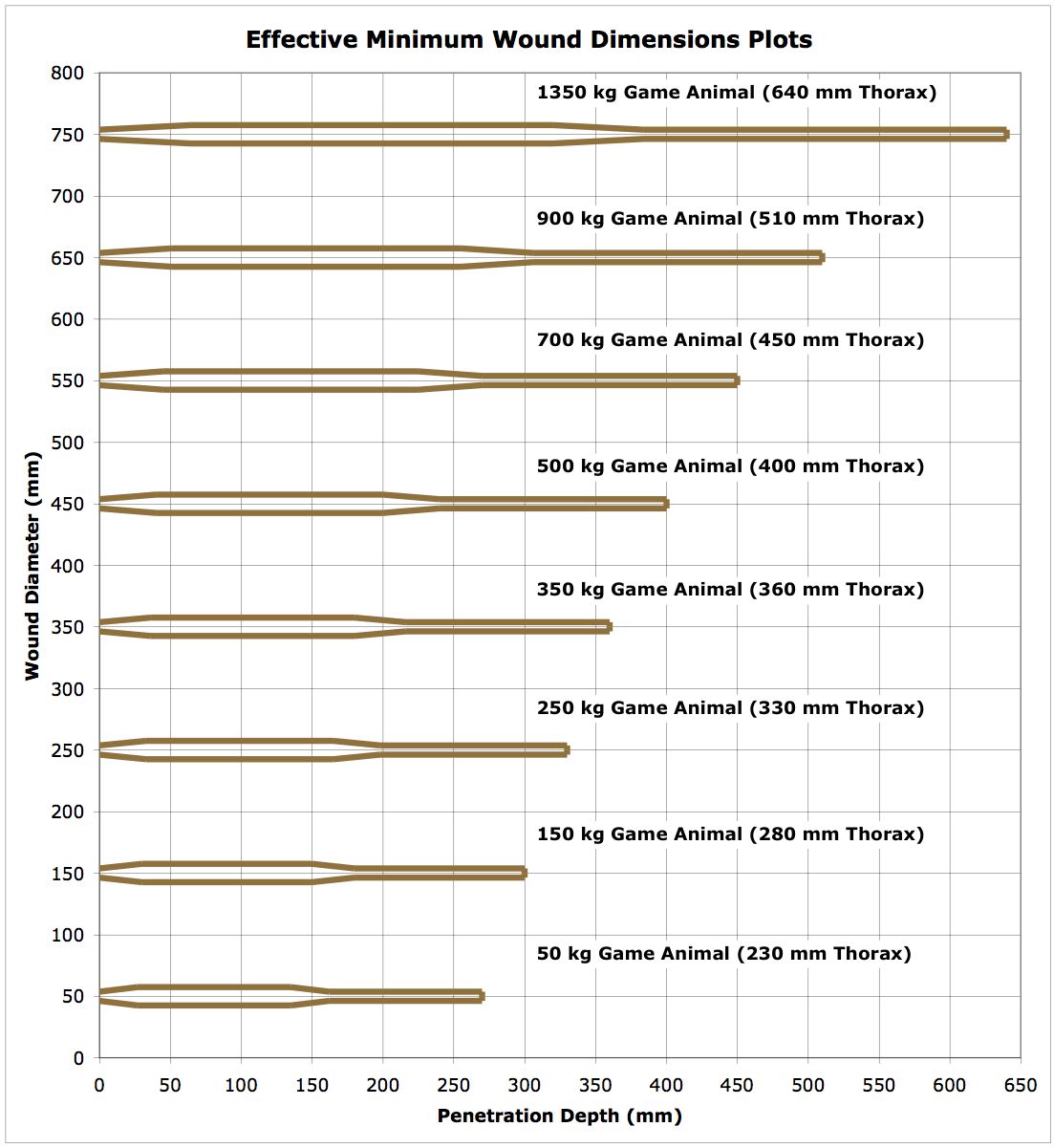
IV. B. iii. Medium-Bore Bullets
I will betray a bias of mine for medium bore rifles and introduce the next discussion - somewhat out of the expected sequence of things - with these calibers. In truth, this is where I began my investigations, so here I will begin the tale. I define medium bore calibers, rather arbitrarily, as those having a maximum bullet weight of greater than 200 grains and less than 400 grains; so its .308 to .375 caliber.
Sciuchetti confined his exhaustive study to a single caliber and bullet weight. Comparable variation to that observed by Sciuchetti are the differences that will be encountered when comparing loads differing caliber, sectional density and/or design. Consider the following selection of data (see Medium Bore Wetpack Test Data) obtained from other published sources, also using saturated phonebooks as a test medium.
Bullets of medium and large caliber often have much stronger jackets than similar designs of lesser caliber. Moreover, the .338 caliber bullets may be inherently stronger than .358 caliber bullets of apparently similar construction because .338 caliber cartridges are almost always magnums with very high muzzle velocities, while the others may include chamberings with relatively low velocities (i.e., the .358 Winchester and .35 Whelen). Nevertheless, I had to exclude two reported tests of .340 Weatherby Magnum loads by Bob Hagel ("8 mm Remington Magnum", Big Bore Rifles and Cartridges, Wolfe Publishing, Inc., 1991, pp. 23 - 27.) which claimed penetrations of 28 and 30 inches respectively for the 210 grain and 250 grain Nosler Partitions. I cannot account for the large discrepancy in these alleged penetrations vis-a-vis the performance of comparable bullets in the .338-06, .338 Winchester Magnum, .340 Weatherby Magnum and .35 Whelen as tested by myself and Finn Aagaard (it could be a typo; the actual values may have been 18 and 20 inches). Various writers have also alleged that the .338 bores will out-penetrate the .375 Holland and Holland; an assertion which I believe is based upon the compared sectional densities of .338-250 grain and .375-300 grain bullets, not actual tests. You will note that the .375 caliber 300 grain Partition meets or exceeds the penetration of .338 and .358 bullets weighing 250 grains. A .375 Holland and Holland 300 gr solid is included in the table for comparison.
Reported Wetpack Test Data for Medium-Bore Rifle Bullets
| Caliber / Cartridge | Bullet Type / Mass | Velocity |
Diameter |
Penetration |
||
| .308 Winchester | 165 gr Nosler Ballistic Tip | |||||
| 165 gr Nosler Partition | ||||||
| .30-06 Springfield | 150 gr Barnes X-Bullet | |||||
| 150 gr Winchester Fail-Safe | ||||||
| 165 gr Barnes X-Bullet | ||||||
| 165 gr Hornady Interlock | ||||||
| 165 gr Nosler Partition | ||||||
| 165 gr Sierra Game King | ||||||
| 165 gr Speer Grand Slam | ||||||
| 165 gr Swift A-Frame | ||||||
| 165 gr Winchester FailSafe | ||||||
| 180 gr Federal Fusion | ||||||
| 180 gr Hornady Interlock | ||||||
| 180 gr Nosler Accubond | ||||||
| 180 gr Nosler Partition | ||||||
| 180 gr Remington Core-Lokt | ||||||
| 180 gr Swift A-Frame | ||||||
| 180 gr Winchester Silvertip | ||||||
| 180 gr Woodleigh Weld-Core | ||||||
| 200 gr x 0.025 Hawk RT | ||||||
| 200 gr North Fork Technologies | ||||||
| 200 gr Swift A-Frame | ||||||
| 220 gr x 0.035 Hawk RT | ||||||
| 220 gr Nosler Partition | ||||||
| 220 gr Sierra Pro-Hunter | ||||||
| 220 gr Winchester Silvertip | ||||||
| 220 gr Woodleigh Weldcore RN | ||||||
| 250 gr Barnes Original | ||||||
| .300 Winchester Magnum | 165 gr Nosler Ballistic Tip | |||||
| 165 gr Nosler Partition | ||||||
| 180 gr Nosler Ballistic Tip | ||||||
| 180 gr North Fork Technologies | ||||||
| 200 gr Barnes X-Bullet | ||||||
| 200 gr Swift A-Frame | ||||||
| 220 gr Hornady Interlock RN | ||||||
| 8 mm Remington Magnum | 150 gr Sierra Pro-Hunter | |||||
| 175 gr Sierra Pro-Hunter | ||||||
| 185 gr Remington Core-Lokt | ||||||
| 220 gr Remington Core-Lokt | ||||||
| 220 gr Hornady Interlock | ||||||
| .338-06 | 230 gr Winchester Fail-Safe | |||||
| 250 gr Nosler Partition | ||||||
| .338 Winchester Magnum | 250 gr Nosler Partition | |||||
| .340 Weatherby Magnum | 200 gr Nosler Ballistic Tip | |||||
| 210 gr Nosler Partition | ||||||
| 210 gr Barnes X-Bullet | ||||||
| 225 gr North Fork Technologies | ||||||
| 225 gr Nosler Accubond | ||||||
| 225 gr Speer Trophy-Bonded Bear Claw | ||||||
| 240 gr North Fork Technologies | ||||||
| 250 gr Nosler Partition | ||||||
| 275 gr Swift A-Frame | ||||||
| .348 Winchester | 200 gr Hornady Interlock FP | |||||
| 200 gr Winchester Silvertip | ||||||
| 220 gr Barnes Original | ||||||
| 220 gr Barnes X-Bullet | ||||||
| 230 gr North Fork Technologies | ||||||
| 250 gr Barnes Original | ||||||
| .35 Whelen | 180 gr Speer Hot-Cor FN | |||||
| 200 gr Sierra RN | ||||||
| 200 gr Remington Pointed Core-Lokt | ||||||
| 220 gr Speer Hot-Cor FN | ||||||
| 225 gr Swift A-Frame | ||||||
| 240 gr Trophy-Bonded Bear Claw | ||||||
| 250 gr Remington Core-Lokt RN | ||||||
| 250 gr Hornady Interlock RN | ||||||
| 250 gr Speer Hot-Cor Spitzer | ||||||
| 250 gr Swift A-Frame | ||||||
| 250 gr Nosler Partition | ||||||
| 270 gr Trophy-Bonded Bear Claw | ||||||
| 275 gr Barnes Original | ||||||
| 280 gr Swift A-Frame | ||||||
| 300 gr Barnes Original RN | ||||||
| 9.3 x 62 mm Mauser | 258 gr RWS H-Mantel | |||||
| 270 gr Speer Soft Point | ||||||
| 286 gr RWS RN Soft Point | ||||||
| 286 gr Nosler Partition | ||||||
| 286 gr Barnes X-Bullet | ||||||
| 300 gr Swift A-Frame | ||||||
| .375 Hawk / Scovill | 250 gr North Fork Technologies | |||||
| 270 gr North Fork Technologies | ||||||
| .375 Holland & Holland Magnum | 270 gr Winchester Fail-Safe | |||||
| 300 gr Nosler Partition | ||||||
| 300 gr Hornady FMJ RN |
-
1 -- Bob Hagel, "8 mm Remington Magnum", Big Bore Rifles and Cartridges, Wolfe Publishing, Inc., 1991, pp. 23 - 27.
2 -- Finn Aagaard, "9.3 x 62 mm Mauser", Handloader, Wolfe Publishing, Inc., June-July, No. 199, 1999, pp. 32 - 37, 78.
3 -- Jim Gosnell, "Legendary Linebaugh Big-Bores", High-Power Handguns, Petersen Publishing, Inc., 1995, pg. 37.
4 -- Independent testing by Øyvind Hannisdal
5 -- Finn Aagaard, "The .35 Whelen", American Rifleman, National Rifle Association, April, 1988, pp. 43 - 45, 82 - 83, 86, 88.
6 -- Independent testing by the author
7 -- Rick Jamison, Nosler Reloading Guide Number 4, pp. 55 - 56.
IV. B. iii. b. .338 Caliber Bullets
Now we come to my favorite caliber, and you can immediately begin to see the beneficial effects of bullet weight and structural integrity on performance. In contrast with the .308 caliber, none of these achieved less than 380 mm (15 inches) in penetration. The table of wetpack test data below corresponds with the figures that follow, illustrating the measured wound tracks in the wetpack.
Wetpack Penetration Data for .338 Caliber Bullets
| Caliber / Cartridge | Bullet Type / Mass | Velocity |
Diameter |
Penetration |
|
| .340 Weatherby Magnum | 200 gr Nosler Ballistic Tip | ||||
| 210 gr Nosler Partition | |||||
| 210 gr Barnes X-Bullet | |||||
| 225 gr North Fork Technologies | |||||
| 225 gr Nosler Accubond | |||||
| 225 gr Speer Trophy-Bonded Bear Claw | |||||
| 240 gr North Fork Technologies | |||||
| 250 gr Nosler Partition | |||||
| 275 gr Swift A-Frame |
The most obvious and striking difference (for me) between conventional wisdom and real world performance is that the .338-200 grain Nosler Ballistic Tip actually outpenetrated the highly regarded .338-210 gr Nolser Partition, and made a respectable but not excessive cavity (although this was one of my very earliest tests and that cavity is anomalous - I intend to repeat that some day). Mind you, this is at an impact velocity not far off the highest muzzle velocity possible; it will only improve with moderated velocity downrange. Many report that the larger caliber Ballistic Tips are serious big game bullets in a different class than their small caliber cousins. I have also found that the larger caliber Partitions produce larger expanded diameters than the smaller bores for the same reason: heavier jacket thicknesses.
These tests also document the behavior exhibited by the Barnes X-Bullet and Winchester Fail Safe designs in Sciuchetti's testing in which increased penetration was observed at the highest velocities because the petals sheared off leaving only a blunt cylinder. In my testing with a 210 grain XBT load in .340 Weatherby it did this at a velocity of 2850 fps, leaving a square-ended blunt cylinder. This petal shearing seems to occur at impact velocities above 2600 to 2700 fps or so. Although the forward portion of the Nosler Partition bullet is also quickly ablated at similar velocities, these bullets (in the medium bores) tend to retain a broad, flat expanded diameter and to penetrate well despite the lost mass, in contrast with a "de-flowered" X-Bullet which penetrates very deeply but leaves a rather narrow wound over the last third of the distance (however, considering that this narrowing behavior occurs beyond the depth at which most good bullets stop and that the broad flat end cavitates more efficiently than a smooth "mushroom", it may not be a detriment). In a smaller caliber the narrow wound might be less than desired but in a medium or large bore (especially) it may make the most efficient use of the kinetic energy of a bullet. I have not yet tested one of the .338 caliber 225 or 250 grain X-Bullets, but its is possible that these will create a cavernous and very deep wound path similar to that produced by the .308-200 gr design. It is also probable, as previously mentioned, that below the petal shedding threshold of ~2700 fps, this 210 grain XBT bullet (now replaced by the TSX design) will make a larger diameter wound track, while maintaining its high penetration. It is a test I need to conduct in the future. Its also possible, although I have seen no evidence of this, that Barnes has solved the heat treatment or strain hardening problem that leads to the petal shearing at high velocity.
The lower velocity (2840 fps) 210 grain Partition and the 250 grain Partition were loaded to impact with identical kinetic energies (3750 ft-lbs). The heavier bullet penetrates 14% deeper while making a slightly larger cavity. The .338-225 gr Trophy-Bonded Bear Claw bullet creates a larger diameter cavity than any other design tested thus far, admittedly at a high impact velocity (2900 fps). It seems to exhibit a singularly violent expansion, yet holds together well and penetrates deeply. Note that the .338-225 grain North Fork beats it for penetration depth, but creates a much narrower expansion cavity. This bullet and the Swift A-Frame design of equal weight should create nearly identical holes at equal impact velocities. Most Swift A-Frames that I have tested have leaned more in the direction of true expansion control and give deeper penetration. This makes sense for Swift because they have the Scirocco for more expansive performance. North Forks can be of either persuasion (controlled expansion or controlled retained weight with large expansion). These three bullets are probably among the most lethal hunting bullets made, but that can be equally said of several other designs, including the Swift Scirocco, Barnes TSX and Nosler Accubond.
Finally, among the conventional bullets the 250 grain Sierra Game King compares very favorably, at this velocity, with the 250 grain Nosler Partition and 240 grain North Fork - no mean feat. It has an extra heavy double tapered jacket and very hard antimony alloy core, so I don't know how readily it will expand at lower velocities. Its a test I need to try. The massive 275 grain Speer Hot-Cor semi-spitzer (now discontinued), on the other hand, would probably only improve with reduced velocity; although its not a bad performer at what is literally muzzle velocity from a .340 Weatherby. All of which simply goes to show that, with some effort, old-school conventional bullets still have their place and can compete head to head with the custom and premium bullets.
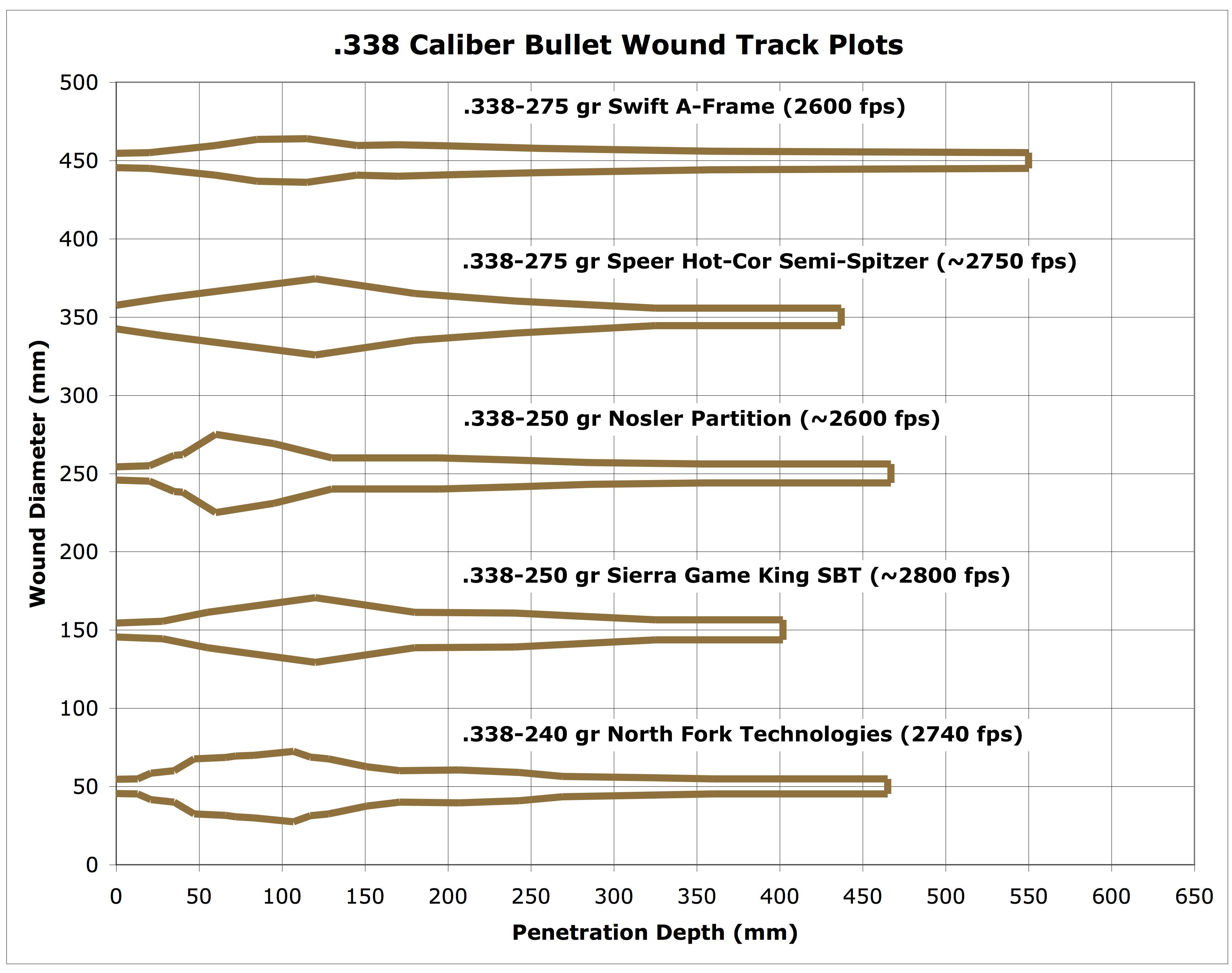
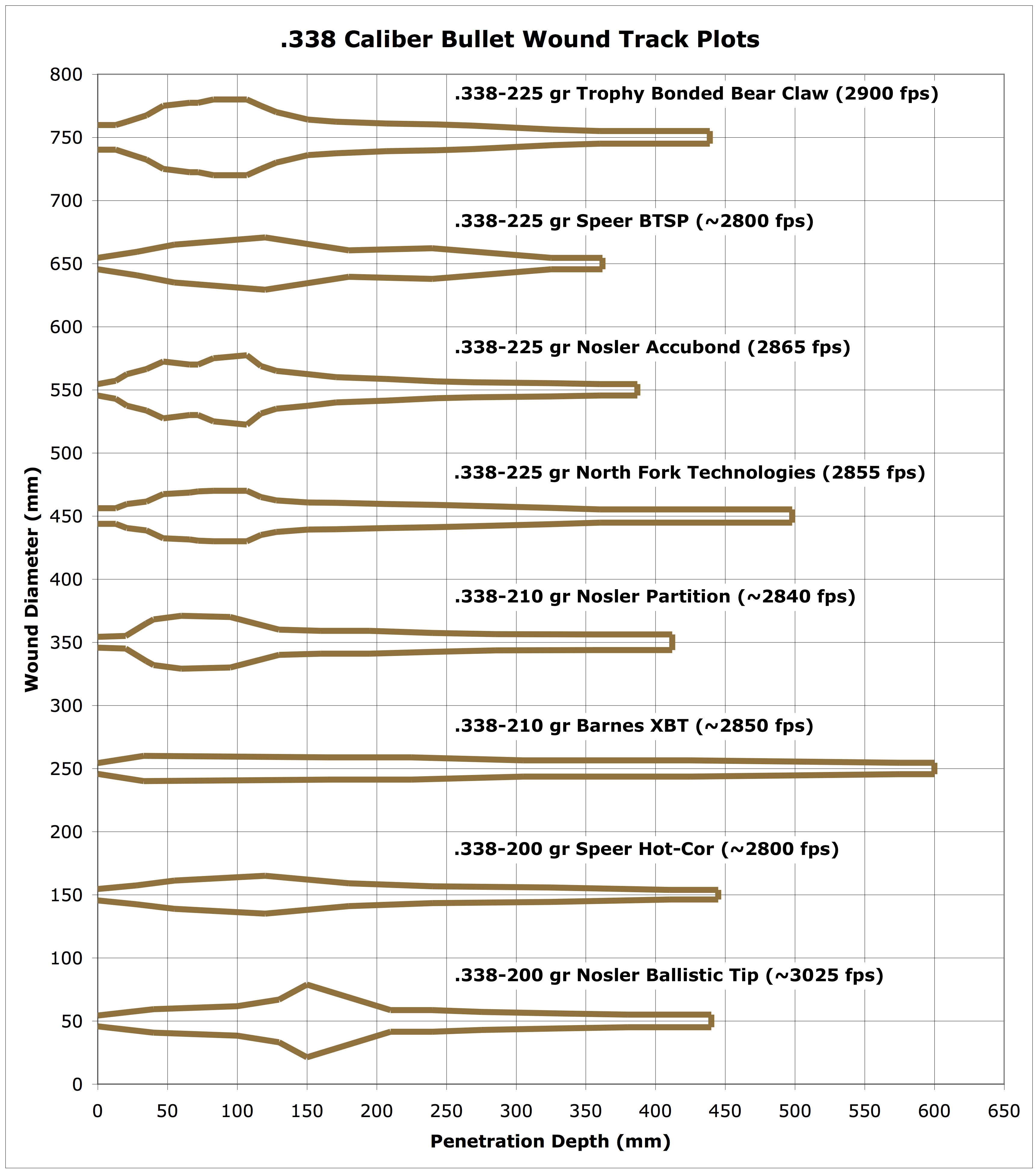
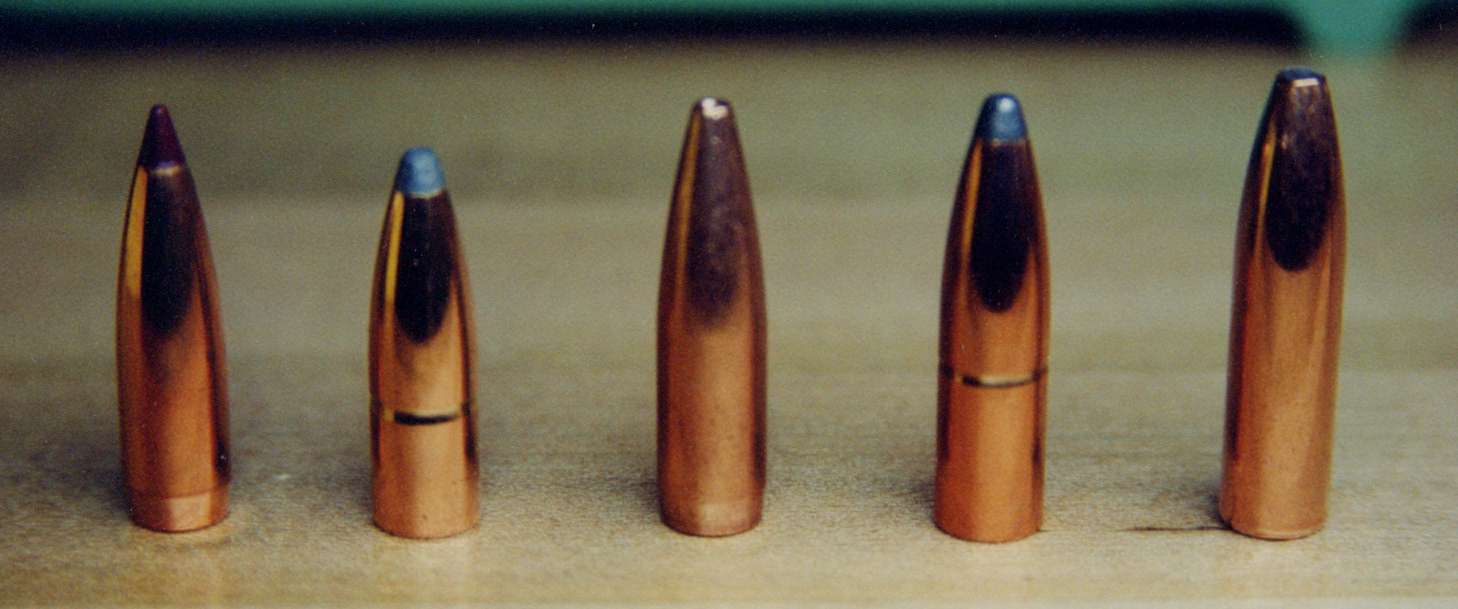
Legend - (L-R) An array of .338 caliber bullets: (1) 200 gr Nosler Ballistic Tip, (2) 210 gr Nosler Partition, (3) 210 gr Barnes X-Bullet, (4) 250 gr Nosler Partition, (5) 275 gr Swift A-Frame

Legend - (L-R) .338 caliber bullets tested in the foregoing figure: (1) 200 gr Nosler Ballistic Tip, (2) 210 gr Barnes X-Bullet, (3) 210 gr Nosler Partition, (4) 225 gr Trophy Bonded Bear Claw, (5) 250 gr Nosler Partition, (6) 275 gr Swift A-Frame
IV. B. iii. c. A Study of Sectional Density
The following parametric study of the effect of sectional density on bullet performance should largely lay to rest the off-quoted generalization that heavy for caliber bullets or bullets of some particular sectional density penetrate deeper and retain more mass. All the bullets used were of conventional construction, meaning lead alloy bullets in drawn copper alloy jackets; no bonded cores, partitions or other special constructions. All were loaded to a muzzle velocity of 2750 to 2800 fps, in order to eliminate the variable of velocity.
A Study of Sectional Density: Medium-Bore
| Caliber / Cartridge | Bullet Type / Mass | Density |
Velocity |
Diameter |
Penetration |
|
| .340 Weatherby Magnum | 200 gr Speer SP | |||||
| 225 gr Speer BTSP | ||||||
| 250 gr Sierra Game King | ||||||
| 275 gr Speer Semi-Spitzer |
In a stunning repudiation of conventional wisdom, the lightest bullet tested (200 grain Speer Hot-Cor) penetrated to the greatest depth and the heaviest bullet (275 grain Speer Hot-Cor) lost the most mass both in absolute terms and on a percentage basis. To be fair, apart from the 200 grain Speer, the bullets performed as one might expect (see the Sectional Density Study Figure below). Still the point I raise remains valid: generalizations are simply that; specific bullets may not behave as expected.
The best looking recovered bullet was the 225 gr Speer boat-tail spitzer, faring better than the more famous Sierra Game King which suffered a core separation (common among boat-tailed bullets) and an asymmetric folding back of the jacket. This latter feature I consider to be potentially a serious flaw because it suggests inconsistency of behavior (and this at a high impact velocity where things ought to be certain), although it could be the result of the bullet yawing in the test and no fault of the design.
I was amazed at the behavior of the big 275 gr Speer semi-spitzer. This bullet has a sectional density of .344 - thats the same as a 500 gr bullet of .458 caliber. If anything, this should be the one to drive like a runaway freight train. At a lower velocity it might, but it expanded more violently than the others (probably due in part to the generous amount of exposed lead in the tip). The wound cavity created can only be described as cavernous. Its not a bad bullet by any means, but possibly no more effective (at this velocity) against tough heavy animals than the little 200 gr Speer, which performed very respectably considering that its an ordinary inexpensive design.
Criticisms with this study might include the high velocity selected. Its true that at lower velocities the semi-spitzer would not have come apart like it did, but presumably the little 200 gr and the 225 gr boat-tail would also perform better. I question whether the 250 gr Game King would even function at an impact velocity below 2200 fps (this is a bullet design that would profit from a serrated jacket and/or a polymer tip insert). One might object to my attempt to remove the variable of velocity, because that implies that these bullets would arrive at targets of varying distance and therefore this is not a fair comparison. Perhaps so. I suspect that the 200 gr bullet loaded to its full muzzle velocity of 3200 fps would probably penetrate about 12 inches and lose 50% or more of its mass. This test (for the 200 grain bullet) corresponds to a range of about 175 yds in the .340 Weatherby but roughly the muzzle velocity from a .338-06 chambering. I wanted the test to be hard on the bullets because under those conditions differences should be most evident, but I feel that this range reasonably covers practical engagement conditions as well.
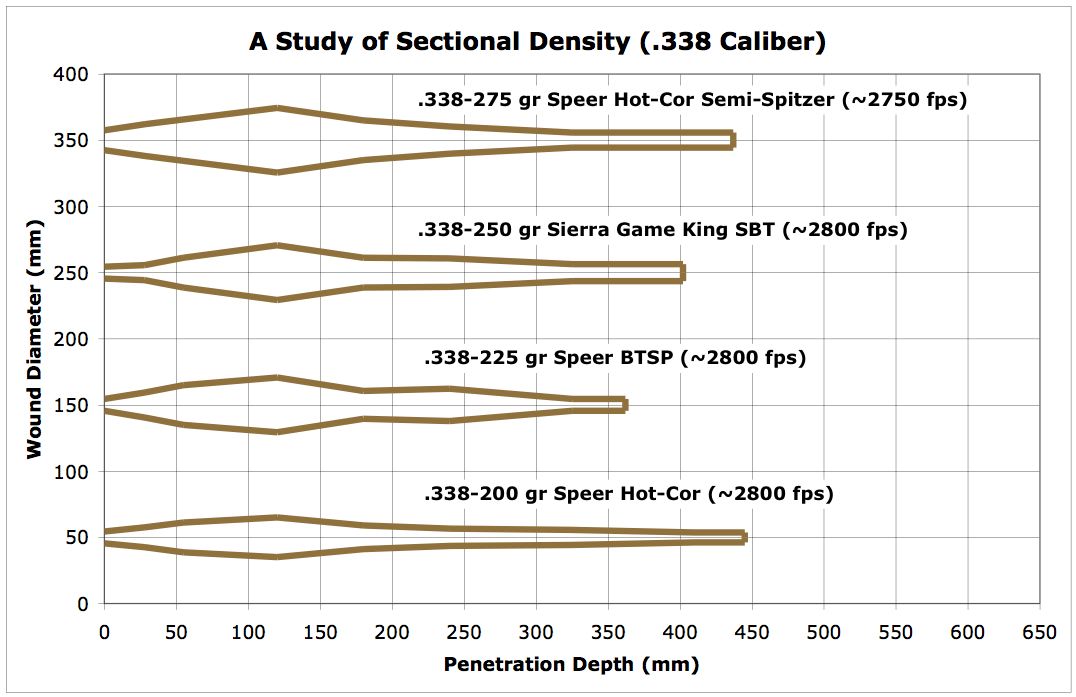
IV. B. iii. d. .348 Caliber Bullets
Previously, I lamented that this caliber was not more popular. But I may have underestimated its cult following. It is remarkable that it is still highly favored among those who use it, given that the Model 71 was discontinued by Winchester in 1955, and only briefly revived in 1986 by Browning in their reproductions of the Model 71. No other rifle has ever used this caliber and yet it endures. In fact, it is presently experiencing a resurgence (perhaps short-lived) because for 2013 Winchester has re-introduced the Model 71 in .348 Winchester. Anyway, its one of my favorites, partly because of its obsolescence and oddity in being the only cartridge ever designed for this caliber.
Wetpack Penetration Data for .348 Caliber Bullets
| Caliber / Cartridge | Bullet Type / Mass | Velocity |
Diameter |
Penetration |
|
| .348 Winchester | 200 gr Hornady Interlock FP | ||||
| 200 gr Winchester Silvertip | |||||
| 220 gr Barnes Original | |||||
| 220 gr Barnes X-Bullet | |||||
| 230 gr North Fork Technologies | |||||
| 250 gr Barnes Original |
Most of the .348 caliber bullets made holes of similar diameter, but the clear standout performers are the six petal flat-nosed X-Bullet design (now sadly discontinued) and the North Fork Technologies 230 grain FN bullet. The 220 grain Barnes XFN load produced the most perfectly mushroomed bullet I have ever observed. It is a six petal design, unlike most X-Bullets which have only four petals. The front surface is very broad and flat and the bullet retained over 99% of its mass, making as large a cavity throughout its depth as any bullet conceiveably could at that impact velocity. Pushed to the same velocity as the Barnes XFN bullet, the penetration depth of the North Fork would likely be even closer to that of the Barnes - its a test that I need to repeat. I had no chronograph when I did my first load work on the North Fork and grossly underloaded it - it manages 2325 fps very nicely in my Browning rifle.
Frankly, the two Barnes Originals do not provide anything of great significance over the basic 200 grain Hornady Interlock, a bullet design that I have long neglected and am growing more and more to appreciate. I only wish that they could see their way to making it a 220 grainer. The heavier Barnes bullet did not expand evenly at the lower impact velocity (possibly due to yaw in the test media?) and you will note that the 220 grainer beat it in penetration, though with a slightly narrower cavity. I would like to see how the newer Hawk bullets compare with these and I have obtained a box of 180 grain Hawk bullets to test (partly to see how the older high velocity load behaved), but the North Fork is a strong contender for the best (still available) design.
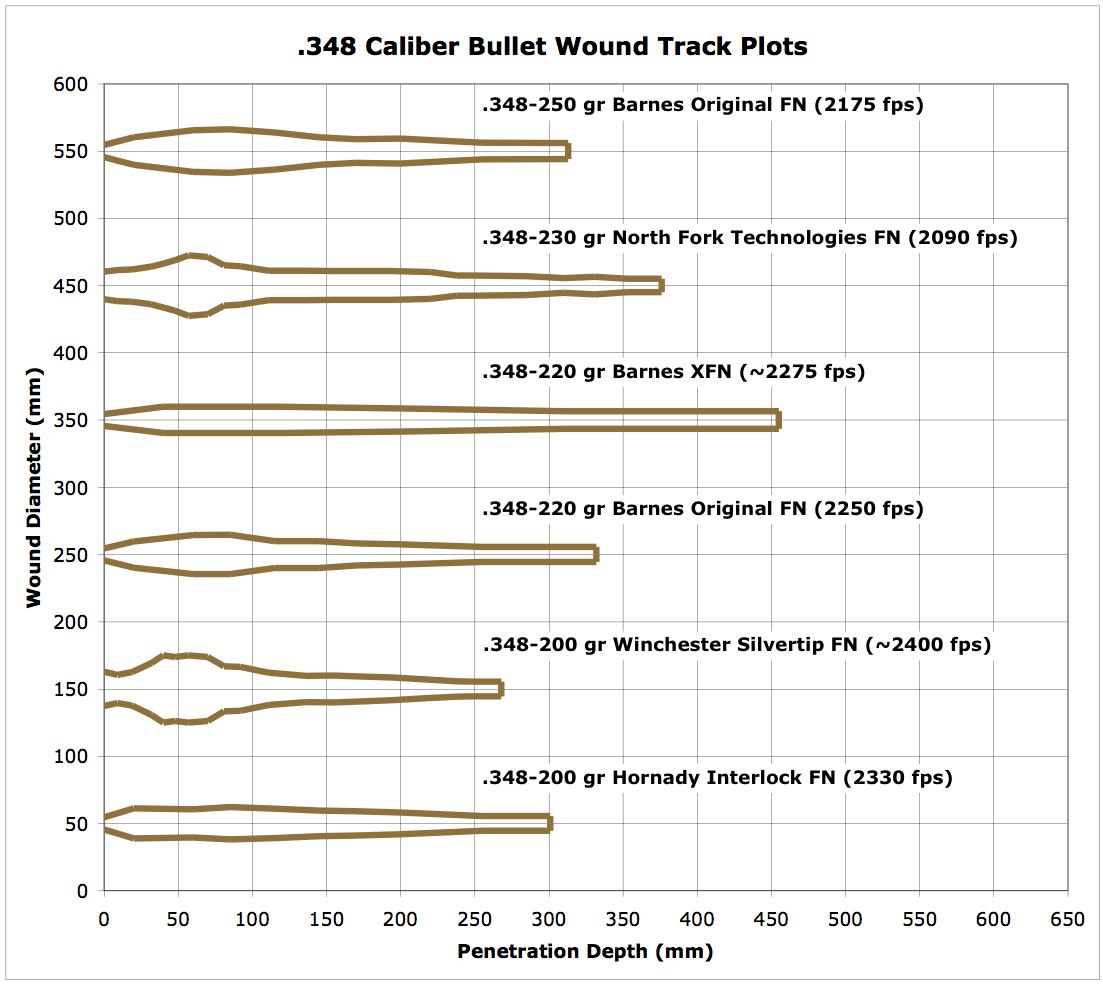

Legend - (L-R) Tested (unfired and recovered) .348 caliber bullets: (1, 2) 200 gr Hornady Interlock, (3, 4) 220 gr Barnes Original, (5, 6) 250 gr Barnes Original, (7, 8) 220 gr Barnes X-Bullet
IV. B. iii. e. .375 Caliber Bullets
I have not had the opportunity to test many .375 caliber bullets as yet, but I intend to do so and publish those results in future. For now, I have the results of two premium North Fork Technologies bullets that I loaded in my .375 Hawk. These performed in broadly similar fashion with other premium medium bore bullets. Despite moderately high impact velocities, they exhibited very high weight retention. While the penetration depths are by no means disappointing, it would seem that the heavy jackets resulted in large expanded diameters that retarded their forward progress more than similar weight bullets at similar inpact velocities in .338 caliber.
Of note, and you will see this reflected in .338 caliber too, the mid-weight North Fork bullet penetrates as deeply as the heavyweight. The slightly higher velocity seemingly offsets the lower bullet weight. That's a trend that is likely to hold true for strongly constructed and bonded bullets. You even see this suggested by the 220 and 250 grain Barnes Original bullets in .348 caliber. While the heavier weights seem to exhibit slightly more cavitation, the mid-weights generally match and sometimes exceed them in penetration depth.
Wetpack Penetration Data for .375 Caliber Bullets
| Caliber / Cartridge | Bullet Type / Mass | Velocity |
Diameter |
Penetration |
|
| .375 Hawk | 250 gr North Fork Technologies | ||||
| 270 gr North Fork Technologies |
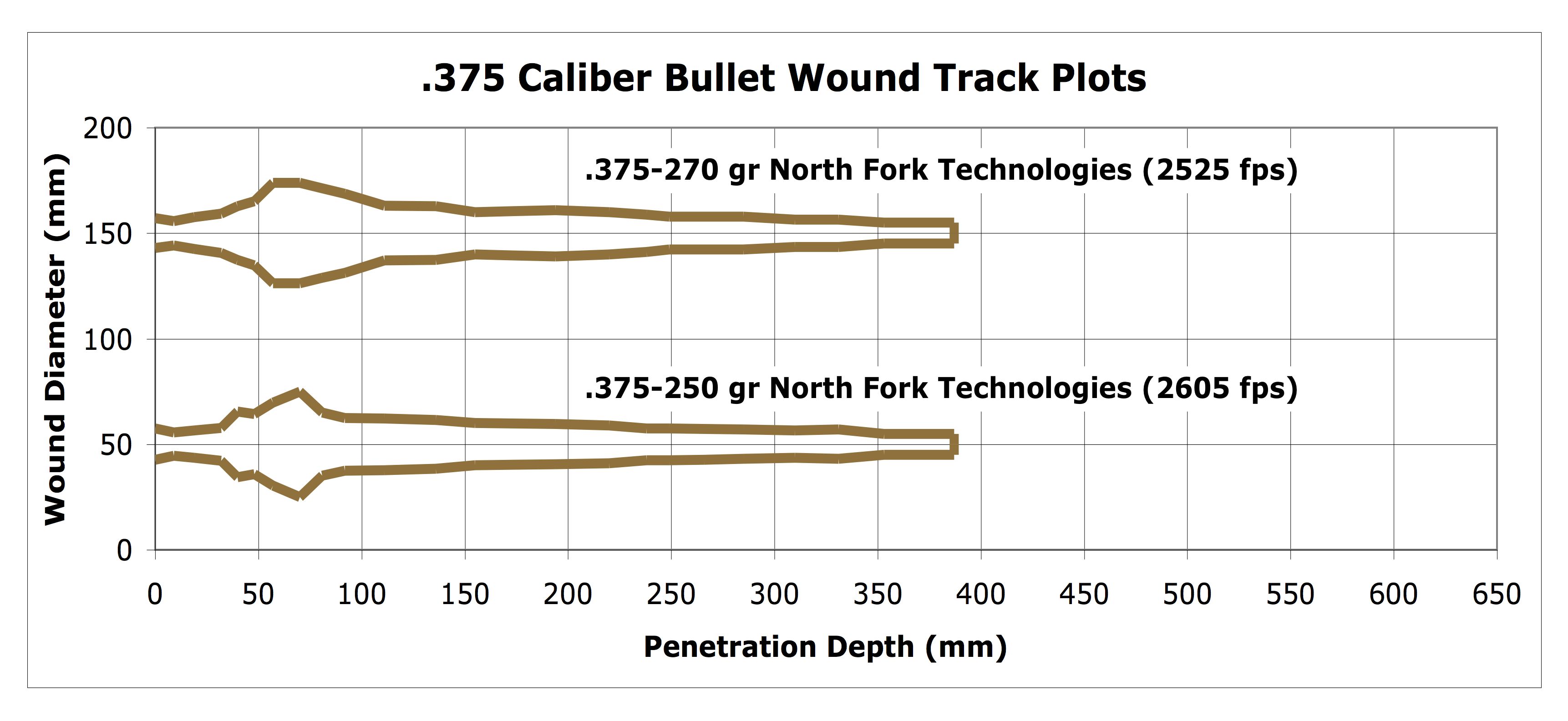
I don't have a large store of test data for small-bore calibers. My personal bias is, as I have confessed, for the medium-bores. I am very fond of the .284 caliber, though, and have a smattering of test data in .243 and .224 caliber. Eventually, I will post some results in .264 caliber.
IV. B. iv. a. .284 (7 mm) Caliber Bullets
The following wound track plots detail the performance of numerous .284 (7 mm) caliber bullet designs in a variety of weights, ranging from 175 to 120 grains. Again, they are arranged in sequence from heaviest to lightest and the scale of the plots is the same as previously presented for the medium bores. Note the velocities associated with the various plots because some bullets are tested at different velocities and comparisons between designs should reflect differences in impact conditions.
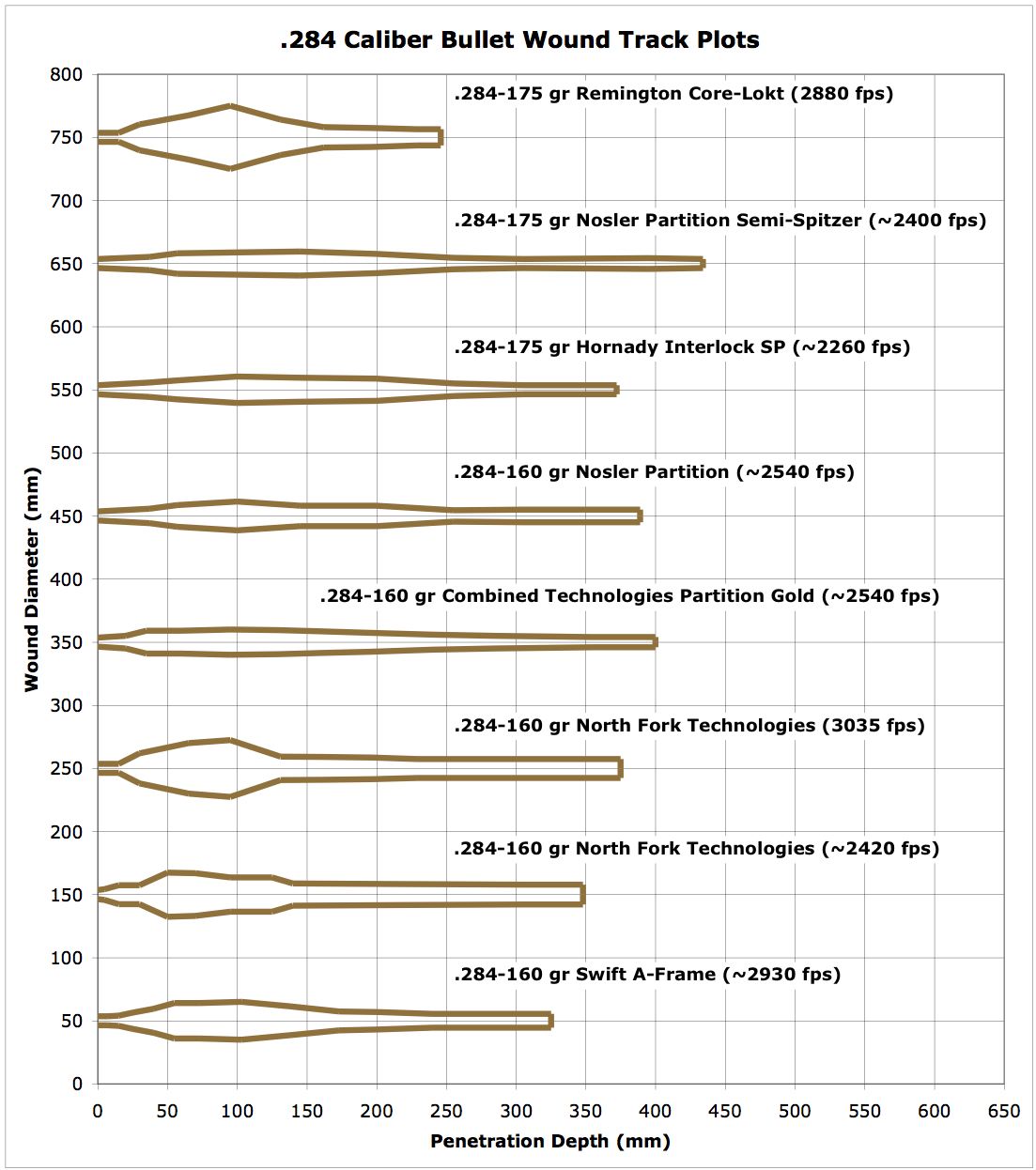
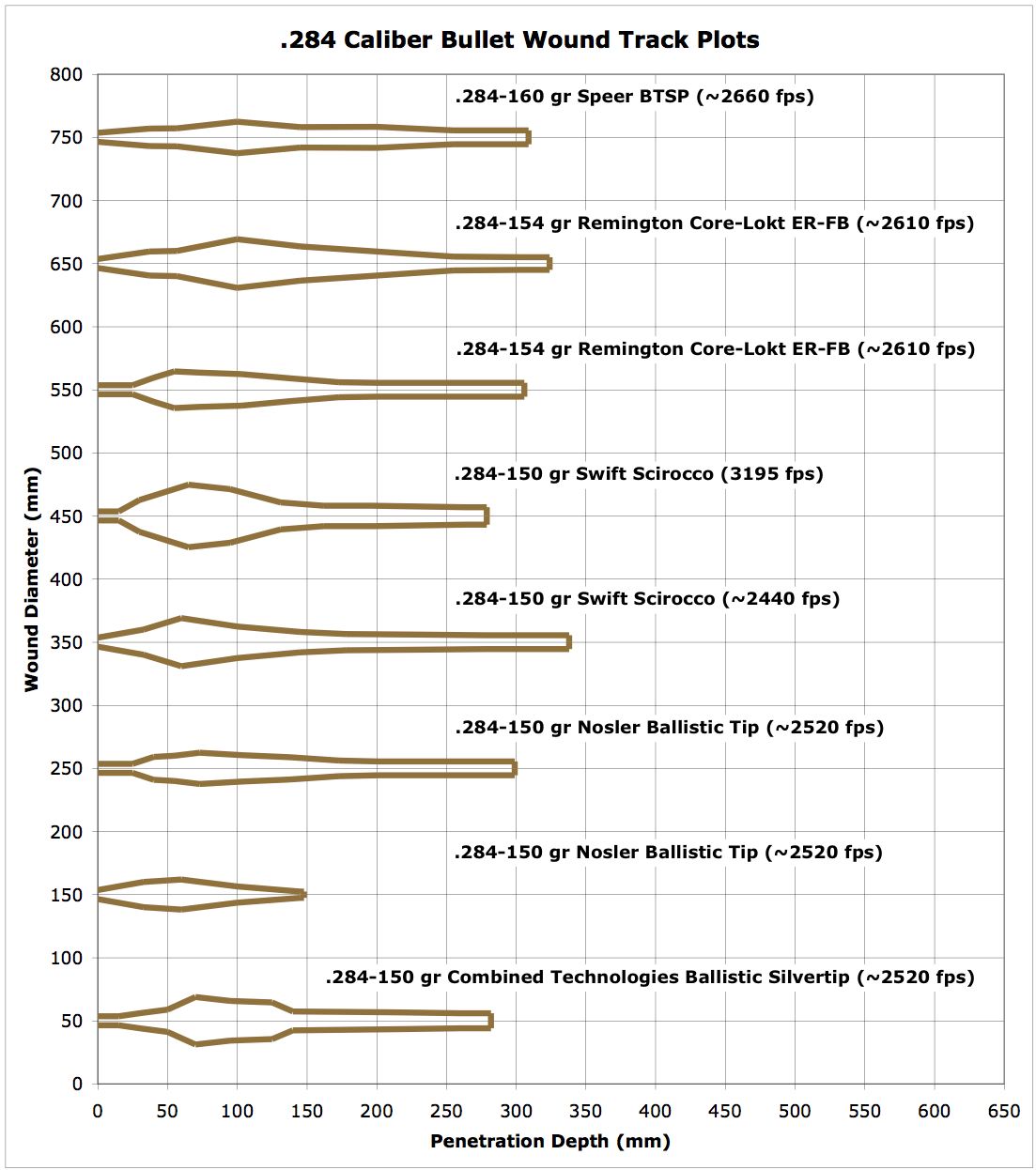
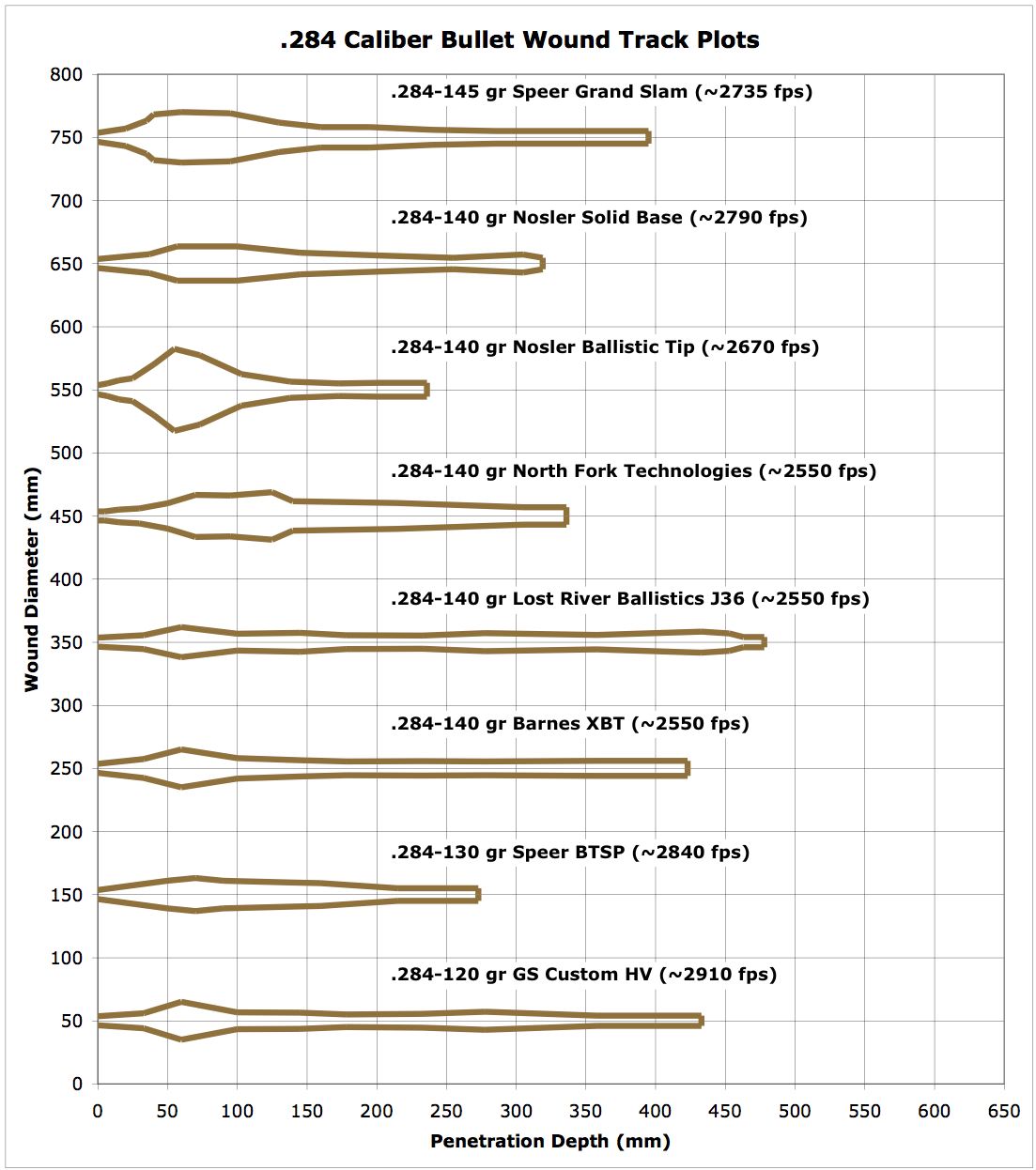
IV. B. iv. c. Another Study of Sectional Density
These small-bore bullets in the 7mm-08 Remington and 7 mm Remington Magnum taken as a whole grossly substantiate the conventional wisdom regarding sectional density. However, I call attention to the (rarely acknowledged) fact that the bullets of lowest sectional density are normally driven to the highest velocities while those of high sectional density are driven to the lowest velocities. Thus we have strongly mitigating factors which may account entirely in some cases for the observed differences. Notice how much smaller the cavities are than for the medium bore bullets (see the Small-Bore Wound Track Plot Figures).
A Study of Sectional Density: Small-Bore
| Caliber / Cartridge | Bullet Type / Mass | Density |
Velocity |
Diameter |
Penetration |
|
| 7mm-08 Remington | 130 gr Speer BTSP | |||||
| 140 gr Nosler Ballistic Tip | ||||||
| 140 gr Nosler Solid Base | ||||||
| 150 gr Nosler Ballistic Tip | ||||||
| 150 gr Combined Technologies Ballistic Silvertip | ||||||
| 154 gr Remington Core-Lokt ER-FB | ||||||
| 160 gr Speer BTSP | ||||||
| 175 gr Hornady Interlock | ||||||
| 7 mm Remington Magnum | 175 gr Remington Core-Lokt |
The little 130 grain boat-tail spitzer is the lightest big game bullet that Speer recommends in 7 mm caliber. It produces a perfectly satisfactory wound for lighter big game taken under typical frontal shot angles, lacking only in deep penetration.
The 140 grain Nosler is the old discontinued Solid Base style. It differs significantly from the newer Ballistic Tip only in the polycarbonate tip insert. However, the behavior of the 140 gr Ballistic Tip is dramatically different. Although I have been satisfied in the field performance, the Ballistic Tip is more prone to failures owing to the violence of the expansion.
For an example of this, look at the three 150 grain Nosler Ballistic Tip bullets shown at the bottom of the middle plot figure. The 150 grain Combined Technologies Ballistic Silvertip tested here made an impressive cavity with decent penetration, but experienced a complete core separation, the jacket deviating from the main path after 227 mm (8.94 in) and a tiny remnant of the core coming to rest at 282 mm (11.1 in). In contrast, the Nosler 150 grain Ballistic Tip performed in a very restrained and satisfactory manner. In a previous test, however, the bullet passed too close to the unyielding table surface (as would be true if a shoulder bone were near the bullet path?) and the entire core literally squirted out like toothpaste, leaving behind a husk of the almost intact and unexpanded jacket. I don't include the retained weight in the table because I did not save the pieces, but its an absurdity to speak of retained weight in a case like this anyway. The penetration was very shallow (148 mm, or less than 6 inches). That middle plot you see is the definition of bullet failure. That is what it looks like - not even a guaranteed big hole for your shallow penetration. I cannot entirely explain it, but that is what I observed. Since there is presumably no difference in these bullets (other than the black coating and grey tip insert on the Winchester brand bullet), the variability is surprising.
The 154 grain Remington Extended Range Flat Base (ER-FB) Core-Lokt bullet is no longer manufactured and it is a tragedy. This was my favorite 7 mm bullet and its a very reliable killer. It compares quite favorably with the 150 gr Swift Scirocco. Why this bullet was discontinued is a perfect example of how the public don't know what they are buying or why. Or maybe its just the stupidity of the marketing division of Big Green. It wasn't sexy enough or the latest trend, so it didn't sell well enough to be retained I suppose.
The Speer 160 grain boat-tail spitzer does not produce either a larger diameter or a deeper wound than either the 140 grain Nosler SB or 154 grain Remington ER-FB, demonstrating again that generalizations regarding sectional density are not meaningful when applied to specific bullets.
The 175 grain Hornady Interlock bullet performed very well despite its low velocity. My brother used this bullet in the 2000 season and got excellent exit wounds and blood (which was unnecessary since one deer dropped in its tracks and the other went only 35 yards). He also got incredible accuracy. Old fashioned bullets still work! Most shocking, the 175 grain Remington Core-Lokt stopped short of the penetration of the tiny 130 grain Speer pill at very nearly the same impact velocity. Once again, the lightest bullet (of the conventional designs) bests the penetration of the heaviest (in one example, at any rate). Of course, it falls well short of the 175 grain Hornady.
What I observe regarding sectional density is that for conventional bullets the penetration tends to increase very gradually (or looks flat) over the middle weights, from a sectional density of 0.225 to 0.275. Its generally only at the weights corresponding to a sectional density of 0.300 or higher that you really start to see any meaningful gain, and even here (as we have seen) there are no certainties. For controlled expansion bullets, a somewhat different trend is observed, but its counter-intuitive. You might expect that for controlled expansion bullets the conventional wisdom regarding sectional density would be exhibited. Often that is the case, but it is also observed that lighter weight bullets edge out heavier bullets. The reason for this may be that, for any given design, the nose deforms consistently between different bullet weights and that the impact velocity is the principal driver (recall that bullets like the North Fork have increased penetration at increasing velocity). So, the lighter bullets may have slightly more kinetic energy and get a bit more penetration.

Legend - (L-R) Some of the .284 caliber bullets compared: (1) 140 gr Nosler Solid Base (discontinued), (2) 145 gr Speer Grand Slam (described in the preceding section), (3) 154 gr Remington Core-Lokt Extended Range Flat Base (discontinued), (4) 160 gr Speer boat-tail (not a Hot-Cor bullet!), (5) 175 gr Hornady Interlock
After digesting the preceding tables and plots, the following data will be more significant by comparison. Many people advocate the use of the very smallest small bores for big game, the .22 centerfires (and even rimfires!). Around August-September 2000, there was an article on this very subject in nearly every gun magazine published in America and all the articles were guardedly in favor. Why this is a bad idea is readily seen in the .224 Caliber Wound Track Figure below. The wound track created by even the most robust of custom bullets is barely acceptable as a minimally effective lethal wound. On anything larger than a 120 lb doe, their use is questionable and even in this regard the utmost of precision accuracy is required. These are varmint cartridges. A 64 grain bullet does not suddenly transform a .220 Swift into a big game cartridge. Thats a sectional density of only .182; even the puny 85 grain .243 caliber bullet is more medicine. But mass is not the greatest problem. Only the Swift Scirocco, Barnes Triple Shock X-Bullet, Trophy Bonded Bear Claw, Nosler Partition and 64 grain Winchester Power Point (favored by law enforcement) are strongly constructed and behave at all like big game bullets in miniature. The long Speer 70 grain semi-spitzer is, despite its mass, apparently no better a performer than a typical 55 to 62 grain soft point (see the table below).
1 -- Finn Aagaard, ".223 Rem - A True Deerslayer?", American Rifleman, National Rifle Association, November, 1992, pp. 40 - 41, 70 - 71.
2 -- Independent testing by the author
IV. B. iv. d. Too Light for Big Game? .224 and .243 Calibers
The Smallest Bores: .224 and .243 Rifle Bullets
Caliber / Cartridge
Bullet Type / Mass
Velocity
Diameter
Penetration
.223 Remington
55 gr Winchester Soft Point
55 gr Winchester Ballistic Silvertip
55 gr Hansen Soft Point
55 gr Trophy-Bonded Bear Claw
60 gr Hornady Soft Point
60 gr Nosler Partition
60 gr Trophy-Bonded Bear Claw
64 gr Federal Power Shok
64 gr Winchester Power Point
64 gr Winchester Power Point
70 gr Speer Soft Point
75 gr Swift Scirocco
77 gr Sierra Match King HPBT
.243 Winchester
80 gr Berger FB HP Match
87 gr Hornady V-Max
100 gr Nosler Partition
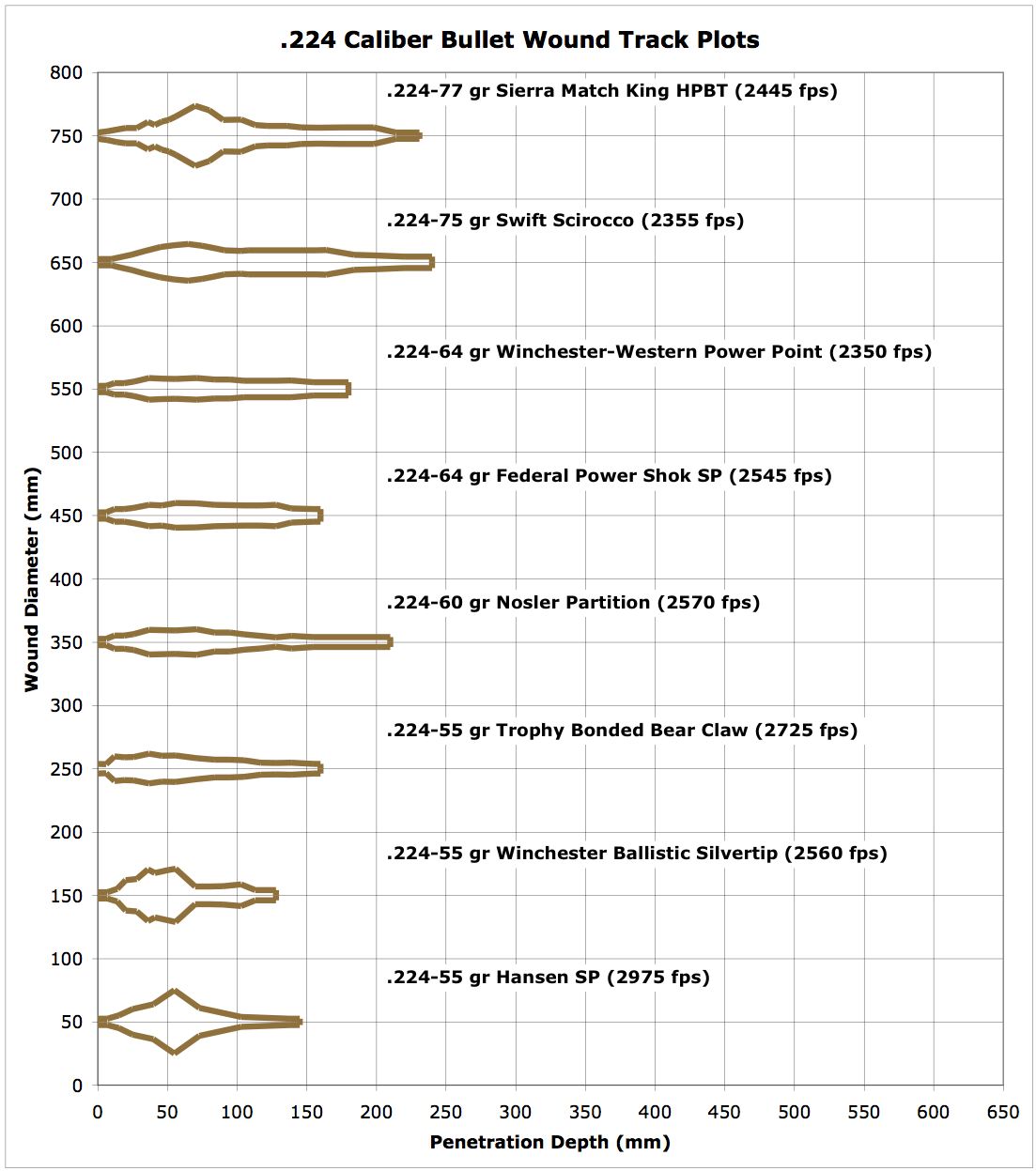
When selecting a .22 centerfire for hunting big game the question I must ask is: Why? What are you trying to prove? It isn't that kinetic energy kills game like lightning because they all have less kinetic energy than even the mildest appropriate weapons. It isn't that retained velocity or flat trajectory is better because .224 bullets invariably have miserable ballistic coefficients (comparable to round nosed bullets or even pistol bullets) and lose velocity like mad beyond 100 yds. It isn't dependable, predictable terminal effect because most .224 bullets are highly frangible and in consequence are highly unpredictable. The only possible argument is familiarity and confidence with a particular rifle and that, friends, is laziness. Use the right tool. It is unethical to play a game in which a failure in precision bullet placement results in a badly wounded animal. On a clear broadside shot they probably kill deer faster than anything you've ever beheld. But those bullets are too close to the margin of failure for any but the most disciplined of marksmen to employ.
If you insist on hunting big game with a .224 caliber rifle, the only bullets worth consideration in my opinion are the 75 grain Swift Scirocco (my recommendation), the Barnes 62 and 70 grain TSX-BT, the 60 grain Nosler Partition and the (now discontinued) 55 or 60 grain Trophy Bonded Bear Claw. Possible consideration might go to the 60 grain Hornady soft point (considered by one authority that I trust to be the best of all the sub-70 grain bullets), the 64 grain Federal Power Shok and the 64 grain Winchester Power Point. Given the existence of the new heavy Scirocco and TSX bullets, I can't see why anything else is on the table. Bullet weight is important in this caliber. Look at the wetpack test result for the 55 grain Trophy Bonded Bear Claw. It has penetration scarcely better than a conventional 55 grain bullet. That may be why its discontinued.
It has been advised that one keep the impact velocity above 3000 fps. I think that advice must be paired with only the partition, bonded and monolithic bullets; it can't be good advice with conventional bullets (it wouldn't be for any other caliber!). In the August-September 2001 issue of Handloader magazine, Ross Seyfried describes a load for a .224 wildcat that uses one of Nosler's new 60 grain Partitions at a scorching 4100 fps, which penetrated over 19 inches in wet paper making holes that looked "like small nuclear explosions" ("Smallbore Extremes", pp. 30 - 35). The jackets on these bullets are much thicker than on the .308 caliber Partitions! Using one of Warren Jensen's J36 bullets (78 grains) at 3700 fps, a penetration depth exceeding 20 inches was achieved. There is some merit to the idea of extremely robust ultra-smallbore bullets with stratospheric impact velocities, but even at this they aren't any better than a .25-06 or similar using conventional bullets at normal velocities.
Many of the staunchest advocates of the .224 hot-rods freely admit to taking head, neck and spine shots (a practice I deplore) when touting the lethality of their beloved caliber. That proves nothing, since any bullet that destroys the brain or spine is instantly fatal. Some will argue that the supposed greater accuracy of .224s permits such precision, but this is arrant nonsense. Field accuracy is less a function of inherent rifle accuracy and more a matter of animal behavior, wind and a steady (or unsteady rest). Heads and necks move a lot more than the thorax of an animal.
I suppose that I am on a rant about this, but it is a disturbing trend, like the current obsession with "ultra-magnums". What comes next? If .224 caliber premium bullets will work, why not .17 caliber? Do we draw the line at abysmal failure?
Take a look at the illustrated wetpack wound track below made by the .243 caliber 87 grain Hornady V-Max varmint bullet. It produced a larger cavity and deeper penetration than any of the tested .224 bullets, except for the 60 grain Nosler Partition (which went deeper, but in a very narrow hole) and 75 grain Swift Scirocco (also deeper, but of modest diameter to ~175 mm depth). It is significantly better than the 64 grain Winchester-Western Power Point load that many think is a good performer (by .224 caliber standards). Think about that. True, the .224 bullets were launched at relatively low velocities and the .243 bullet at a scorching 3200 fps, but while pulling the impact velocities closer together would likely draw the resulting wound tracks more similarly, it still leaves the point: the best .224 bullets are no better than a varmint bullet in .243 caliber. Who thinks that a .243 varmint bullet is a good load for deer?
After my 2000 season experience using the .243 Winchester I don't feel terribly confident in this caliber for big game either. My brother killed a 140 lb doe and a 200+ lb buck with one shot each diagonally through both lungs using Winchester 100 grain Power Points. The doe sat down but didn't die for a full minute. The buck ran 85 yards. Neither bullet exited and the entrance holes couldn't be found until the animals were skinned. Both bullets seemed to perform reasonably well. He was hunting in alfalfa fields in Montana and neither animal escaped. I shot two does on separate days not long after that in Alabama and lost both of them as they ran into an overgrown clearcut full of shoulder high young pines and briar thickets. Neither left any discernible blood trail and I searched in a fan extending well over 100 yards through the maze of brush without finding the carcasses. The drizzling rain and countless other recent tracks didn't help. I was using the 100 grain Nosler Partition load shown in the .243 Caliber Wound Track Figure (compare it to the lightest 7 mm bullet). Obviously, the .243 calibers are enough gun, but only just barely so (compare with the minimum wound illustration for a 50 kg game animal at the bottom of the plot). In open country this caliber is fine on lighter species of big game, but I won't choose it again for heavy cover. I suspect that the varmint loads illustrated would have proven instantly fatal. They might also have blown apart on the scapula or even a rib. It would be interesting to know the risk and probability tradeoff between the chance of a bullet failure and the likelihood of losing a mortally wounded deer. Regardless, I'll stick with my 7 mm.
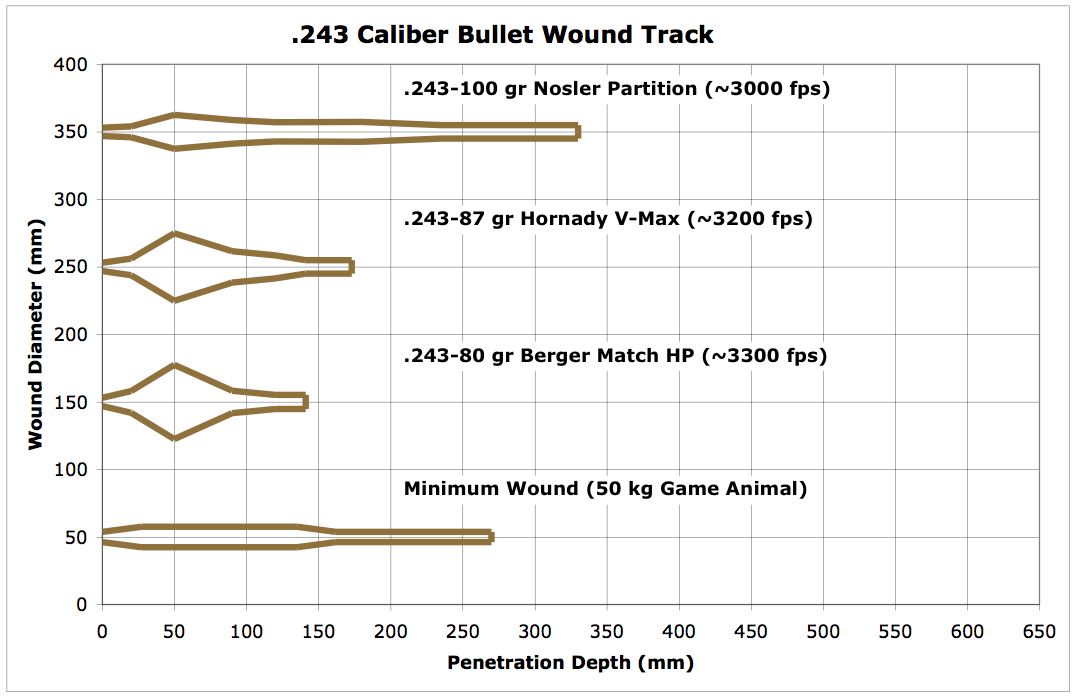
The following tabulated data for standard service sidearm automatic and magnum revolver handgun ammunition further illustrates the relative (im)potency of the .22 centerfires as weapons for hunting big game. It also points to the interest in better loads for handguns than hollowpoints for anything other than small deer under benign shooting conditions (i.e., standing broadside at close range).
Wetpack Test Data for Automatic & Magnum Revolver Handgun Bullets
| Caliber / Cartridge | Bullet Type / Mass | Velocity |
Diameter |
Penetration |
||
| 9 x 19 mm | 115 gr Winchester Silvertip HP | |||||
| 124 gr Starfire HP | ||||||
| 147 gr Winchester Black Talon HP | ||||||
| .40 Smith & Wesson | 180 gr FMJ-FP | |||||
| 180 gr Winchester Black Talon HP | ||||||
| 10 mm Auto | 175 gr Winchester Silvertip HP | |||||
| 180 gr Starfire HP | ||||||
| 200 gr Winchester Black Talon HP | ||||||
| .41 Remington Magnum | 170 gr Sierra Power Jacket JHC | |||||
| 210 gr Hornady JHP | ||||||
| 210 gr Hornady XTP-HP | ||||||
| 240 gr Winchester-Western Platinum Tip HP |
-
- 1 -- Martin P. Olsen, "9mm v. 10mm High Performance Ammunition Tests", Rec.Guns FAQ, IV. Comparative Firearm Information, G. Calibre Issues, http://www.recguns.com.
- 2 -- Independent testing by the author
- 1 -- Martin P. Olsen, "9mm v. 10mm High Performance Ammunition Tests", Rec.Guns FAQ, IV. Comparative Firearm Information, G. Calibre Issues, http://www.recguns.com.
The figure below depicts the wound tracks created in testing with saturated phonebooks by a standard service sidearm in .40 S&W chambering and a .41 Remington Magnum revolver firing conventional 170, 210 and 240 grain hollowpoint bullets. Most of the .41 Magnum wetpack cavities look pretty much the same. The surprise and disappointment is the big 240 grain Winchester Platinum Point. This is basically an overgrown Ranger SXT (aka Black Talon) and its over-large expanded diameter inhibits deep penetration, while creating no larger a cavity than you get with a standard 210 grain hollowpoint. Its not worse than a plain 210 grainer, but its no better. You see a similar consequence with the Extremem Terminal Performance (XTP) version of the Hornady 210 grain hollowpoint versus the old style from the 1980s; more expanded diameter and less penetration.
As a point of reference I have included a .40 Smith & Wesson 180 grain FMJ load. This behaved very much like a solid would be expected to behave until near the end of its travel when it yawed and did a complete endover. Fascinating, huh? This load and the 180 grain Winchester Ranger SXT Black Talon load illustrated just above it had the same kinetic energy, but you see which created the largest permanent cavity. The FMJ achieved literally three times the penetration. Expanding bullets in low velocity loads are not really efficient and this is why savvy handgun hunters prefer wide flat-nosed solids. Recall that heavy, large caliber, flat-nosed handgun bullets can be expected to penetrate 30 to 50 inches while creating a 3/4 to 1 inch diameter wound channel.
You will observe that generally speaking these handgun loads produce larger and deeper cavities than the .224 bullets. If the better hunting bullets in .224 caliber (e.g., the 75 grain Swift Scirocco) perform as suggested by the data in the foregoing section, then the suitability of these cartridges for big game is roughly comparable to the large-bore magnum handgun with hollowpoint loads. Or, turned around, magnum handgun hollowpoint loads are only marginally better than .22 centerfire loads for hunting. Take your pick.
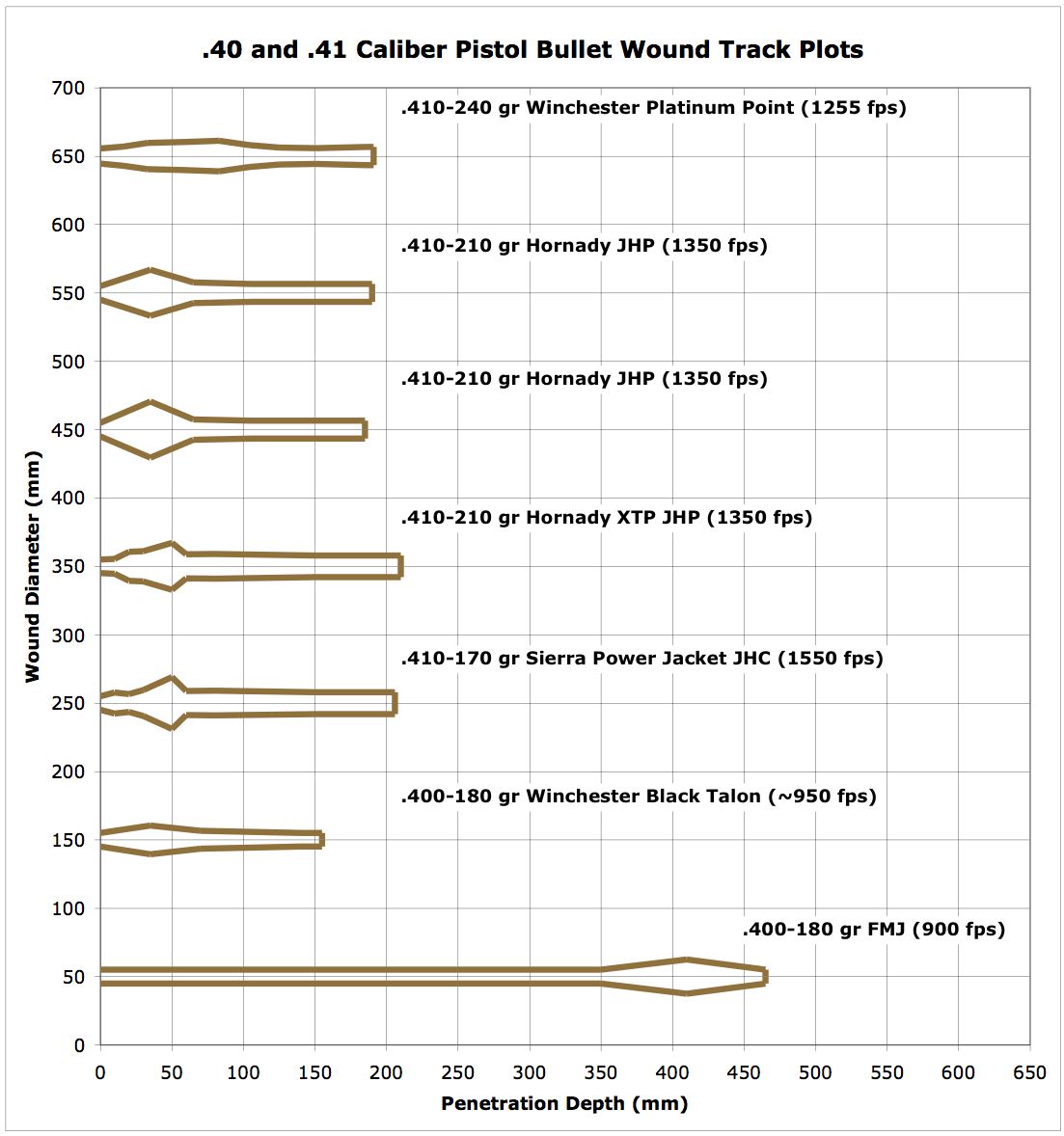
Of some interest is the compared performance of some notably larger calibers, presumed to be proportionately more effective, particularly in terms of penetration (see the Large-Bore Penetration Table and Wetpack Wound Track FigureIV. B. vi. Large-Bore Bullets
Observe that most bullets and loads for the potent 45-70 yield very similar penetration as compared to the .308 caliber bullets examined in detail and generally less than the medium bore loads described in the preceding table. Necessarily these .458 caliber bullets typically produce wound tracks larger in diameter than those produced by small-bore projectiles, but not evidently than medium-bore bullets when the effect of generally higher velocities is considered (and compare the .458-300 grain Barnes X-Bullet at 1930 fps with the .284-150 grain Swift Scirocco described earlier).
Although most of these loads produce similar velocities, the two 403 gr Trophy Bonded bullets (an old design very similar to Barnes copper tubing bullets) exhibit the same penetration with different impact velocities, consistent with the observed behavior of .308 caliber bullets. This is further borne out by the 350 grain Hornady FN bullets in my testing at velocities 500 fps apart, where similar depths of penetration are found although the cavities produced are quite dissimilar. In contrast, when there is little or no expansion they penetrate roughly twice as deeply.
Jamison indicates in the cited reference that the 350 gr Hornady RN soft points yawed during penetration and were recovered in a base forward orientation. This curious result (from 2 shots) differs considerably from the behavior of the slower (1765 fps) and faster (3000 fps) tests. Possibly the jacket failed to deform evenly; the photograph seems to demonstrate this. Nevertheless the penetration is the highest among tests of this bullet and the cavity produced must have been of respectable dimensions, so it is difficult to characterize the result as a failure. I have observed this sort of yawing in several wetpack tests, usually late in the penetration.
In my own testing, two .458 caliber bullets were recovered in a sideways or base forward orientation: the 300 grain Barnes X-Bullet at both 1400 fps (sideways) and 1930 fps (reversed) and the low velocity Hornady 350 grain Interlock FN. The latter bullet is a new design very similar to the older round nose bullet, apparently in response to the demands of Marlin users who were concerned about the round nose impacting the primers in a tubular magazine. This bullet must be seated below the crimping groove to feed in a Ruger No. 1, which is not Hornady's fault, but Ruger's for making such a short throat; a long time problem on that rifle. The high velocity load created a gigantic cavity that exploded outward toward me (rather like the .338-275 Speer semi-spitzer had done at high impact velocity), but the bullet retained 93% of its weight!
I am surprised that the 300 grain X-Bullet lost its petals at the relatively low velocity of 1930 fps, but its cavity is gaping and so the walls are unusually thin. It could be improved by a narrower taper so that the petals opened but held on. It did not penetrate as I expected but it made a respectable hole. This bullet will expand at very low velocities as evidenced by the second shot at 1400 fps, which performed very similarly to a magnum handgun bullet.
Surprisingly, the Barnes Original 300 gr failed to deform at a very high (for the 45-70) velocity of 1992 fps; only the exposed lead nose was scraped away. The nose taper is rather steep and if the bullet started to yaw it could easily get into a condition in which expansion would not occur. Deep penetration and probably a larger wound path was created by the similarly non-deforming Remington 405 gr soft point, but this had an impact velocity of only 1103 fps, so that is not surprising behavior, and in fact you would want a tough bullet to respond in this way.
The Speer 350 gr. FN is billed as a high velocity soft nose for the .458 magnum, so I did not expect much expansion at the 1930 fps impact velocity out of the .45-70, but it performed well. It also performed well at a near muzzle velocity (from the .458 Winchester Magnum) of 2400 fps, but at a very low impact velocity of approximately 1400 fps it apparently did not expand or did so only to a very slight degree and unfortunately exited the test box (Incidentally, this is the sort of hole that would be made by a non-deforming hardcast flatnose bullet, hence the need for a very broad flat point). It is a good bullet in the hotter .45-70 loads where deep penetration is desired, but needs a minimum velocity probably closer to 1600 to 1700 fps for expansion. I was impressed by the 500 grain Hornady RN softpoint at the rather modest velocity of 1985 fps. It cavitated a surprisingly large hole yet achieved just over 20 inches of straight-on penetration. That is outstanding.
Judging by the reported test results, in the .450 Ackley Magnum, the 400 grain Barnes X-Bullet performs about as well as the 500 grain Hornady soft point, and the 500 grain X-Bullet penetrates significantly deeper. Observe that the 600 gr Barnes Original bullet fired from a .460 Weatherby Magnum penetrates less deeply than the Hornady 500 gr softpoint, despite its greater sectional density; here being a classic example of the misleading character of the calculated sectional density of an unfired bullet as applied to its terminal effect. The extremely high velocities of the .460 Weatherby Magnum (though these impact velocities are practical muzzle velocities, not reasonable field conditions) removes bullets of normally robust construction from consideration as projectiles of choice to be used against heavy game at close range, though their use at lower velocity is perfectly acceptable. Super-magnum cartridges do not necessarily provide more killing power; the only assured things are flatter trajectory and heavier recoil (and in this case a potential close range non-engagement zone for some loads).
You see a similar situation for the original style .510-570 grain Woodleigh Weldcore softnose, an excellent bullet, but one which is better suited to impact conditions corresponding to the .500 Nitro Express than the .500 A-Square Magnum and its ilk. Such monsters provide the impression of irrestible power, but in fact you may be less well armed than if you were using a turn-of-the-19th-century vintage nitro express loading with a good quality bullet like the Woodleigh. After all, if extreme penetration is wanted you use a solid, right? Any of the old standard loads with a good solid will penetrate a Cape buffalo from stem to stern or pass through an elephant's skull from any direction. Trying to make a softpoint behave like a solid by firing it from a monster magnum big-bore is pointless, to say the least. And if the idea is to shock a buffalo to death with kinetic energy, well that will result in disappointment.
In parting, its interesting to note that ancient loads for what were once thought to be small-bore rifles can deliver excellent penetration while producing a respectable wound cavity. Witness the penetration of the heavy cast lead match bullet from a .45 Sharps (2-7/8 inch, aka .45-110) shown in the table below. This kind of load and performance was what Frederick Courtenay Selous relied on for twenty years during the heyday of African hunting in the 1870s to 90s. I wish I knew what was the expanded diameter and retained weight of the recovered bullet, but its clear that it did expand, else it would have penetrated a lot farther.
Reported Data for Large-Bore Rifle Bullets
| Caliber / Cartridge | Bullet Type / Mass | Velocity |
Diameter |
Penetration |
||
| .444 Marlin | 240 gr Remington Softpoint | |||||
| 250 gr Nosler Partition | ||||||
| 265 gr Hornady FP | ||||||
| 270 gr Speer Gold Dot | ||||||
| 280 gr Speer Gold Dot | ||||||
| 300 gr Speer Plated Soft Point | ||||||
| 300 gr Hornady XTP HP | ||||||
| 315 gr RCBS Cast SWC | ||||||
| 335 gr Buffalo Bore Cast LBT FN | ||||||
| .45-70 Springfield | 300 gr Barnes Original FN | |||||
| 300 gr Hornady HP | ||||||
| 300 gr Sierra HP | ||||||
| 300 gr Federal HP | ||||||
| 300 gr Remington HP | ||||||
| 300 gr Winchester HP | ||||||
| 300 gr Barnes X-Bullet | ||||||
| 350 gr Trophy-Bonded Spitzer | ||||||
| 350 gr Trophy Bonded FN | ||||||
| 350 gr Hornady Interlock RN | ||||||
| 350 gr Hornady Interlock FN | ||||||
| 350 gr Speer Hot-Cor FN | ||||||
| 350 gr SAECO FN | ||||||
| 400 gr Speer FN | ||||||
| 403 gr Trophy Bonded RN | ||||||
| 405 gr Remington SP | ||||||
| 415 gr LBT LFN | ||||||
| .45 (2-7/8 inch) Sharps | 543 gr Match (Cast Lead) | |||||
| .458 Winchester Magnum | 350 gr Speer Hot-Cor FN | |||||
| 500 gr Hornady Interlock RN | ||||||
| .450 Ackley Magnum | 400 gr Barnes X-Bullet | |||||
| 465 gr A-Square Dead Tough | ||||||
| 500 gr Hornady Interlock RN | ||||||
| 500 gr Barnes X-Bullet | ||||||
| .460 Weatherby Magnum | 350 gr Hornady Interlock RN | |||||
| 500 gr Hornady Interlock RN | ||||||
| 600 gr Barnes Soft Point RN | ||||||
| .470 Nitro Express | 500 gr Woodleigh RN | |||||
| .500 Nitro Express | 570 gr Woodleigh RN | |||||
| .500 A-Square | 570 gr Woodleigh RN |
-
- 1 -- Rick Jamison, "Big Power at Close Range", Shooting Times, May 1997.
- 2 -- John Wooters, "Premium Big-Bore, Big-Game Bullets", Guns & Ammo, December 1984, pp. 61,91.
- 3 -- Bob Hagel, ".460 Weatherby", Big Bore Rifles and Cartridges, Wolfe Publishing, Inc., 1991, pp. 328 - 332.
- 4 -- Independent testing by Øyvind Hannisdal
- 5 -- Brian Pearce, "The Underrated .444 Marlin", Handloader, Wolfe Publishing, Inc., No. 206, August-September, 2000, pp. 62 - 67.
- 6 -- Independent testing by the author
- 7 -- Kent M. Batchelor, "Penetration Test at the Linebaugh Seminar", http://www.sixgunner.com/linebaugh/penetration_test.htm.
- 8 -- Independent testing by Michael Strandberg
- 9 -- 2002 - 2004 Linebaugh Seminar penetration test data reported at: http://www.handloads.com/misc/linebaugh.penetration.tests.asp
(References: http://www.sixgunner.com/linebaugh/penetration_test.htm, http://forums.sixgunner.com/topic.asp?TOPIC_ID=5110, http://forums.sixgunner.com/topic.asp?TOPIC_ID=10571) - 1 -- Rick Jamison, "Big Power at Close Range", Shooting Times, May 1997.

Legend - (L-R) Some tested .458 caliber bullet designs: (1, 2) 300 gr Barnes X-Bullet (unfired and recovered from 1930 fps), (3 - 5) 350 gr Hornady Interlock FN (unfired and recovered from 1400 and 1900 fps), (6, 7) 350 gr Speer Hot-Cor (unfired and recovered from 1930 fps)

Legend - (L-R) A range of .458 caliber bullets (recovered from wetpack tests): (1, 2) 300 gr Barnes X-Bullet (1400 fps and 1930 fps), (3, 4) 350 gr Hornady Interlock FN (1400 fps and 1900 fps), (5, 6) 350 gr Speer Hot-Cor (1930 fps and 2400 fps), (7) 500 gr Hornady Interlock RN (1985 fps)
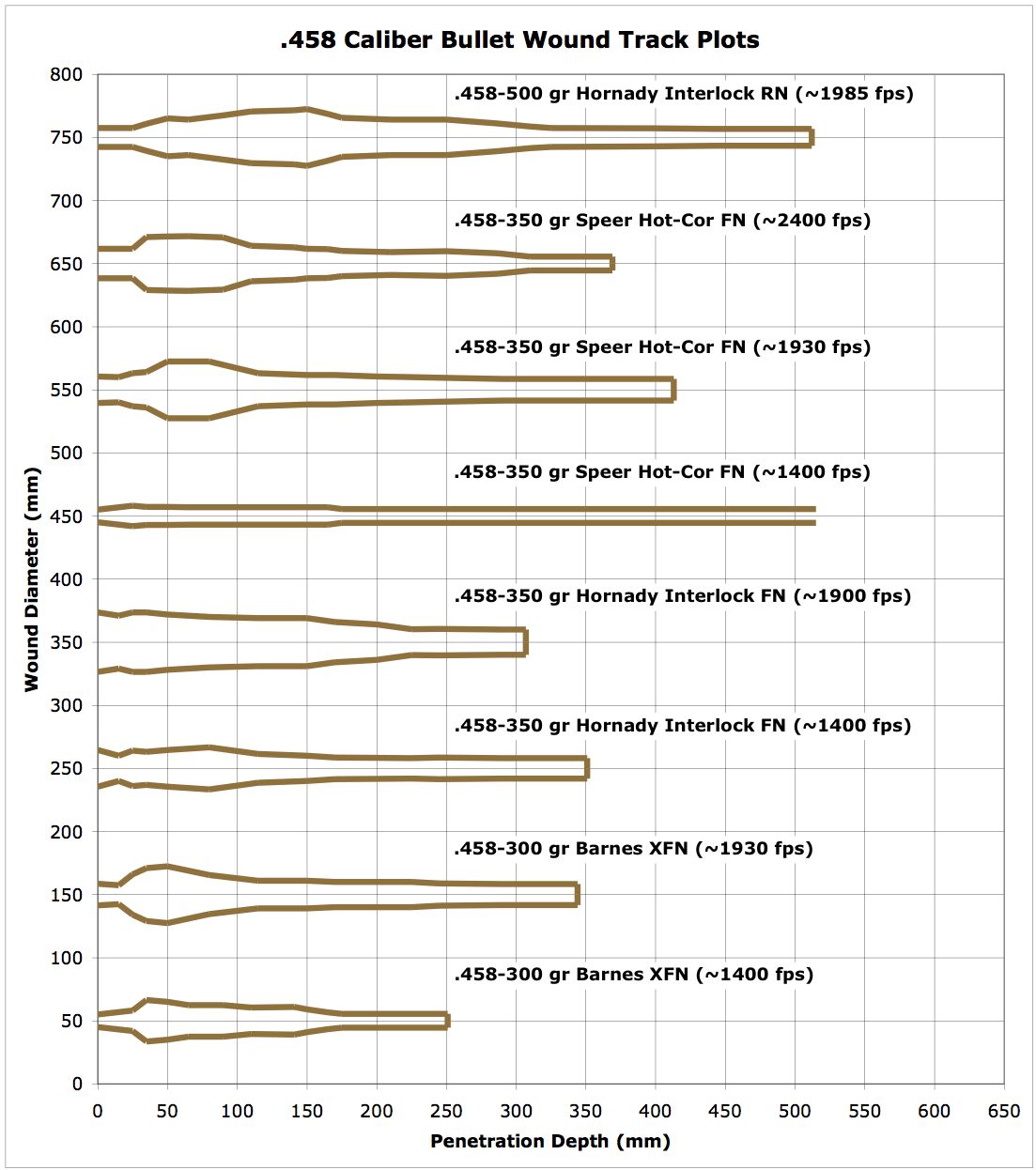
Continue on to:
V. Analytical Modeling of Terminal Ballistics
Return to:
Contents
Mail to: Ulfhere at Rathcoombe.net Copyright 1999 - 2013 -- All Rights Reserved
